#cologne post war architecture
Explore tagged Tumblr posts
Text
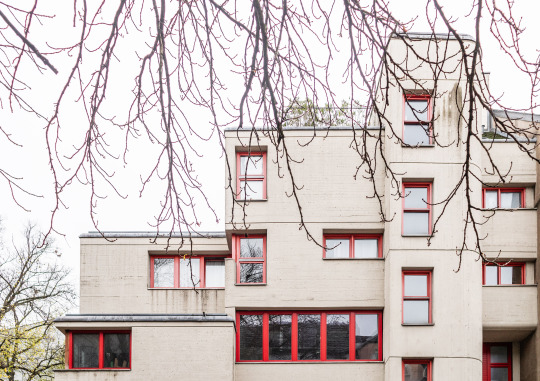
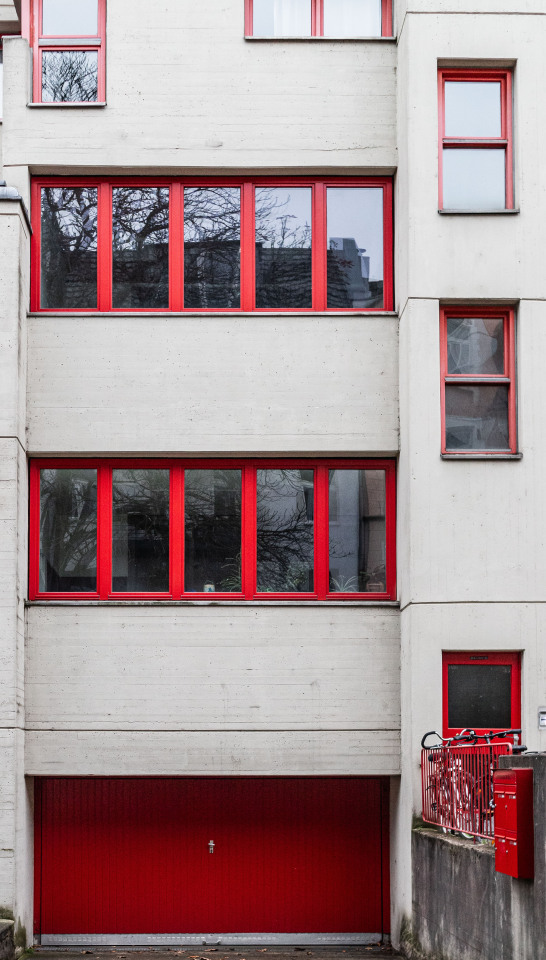
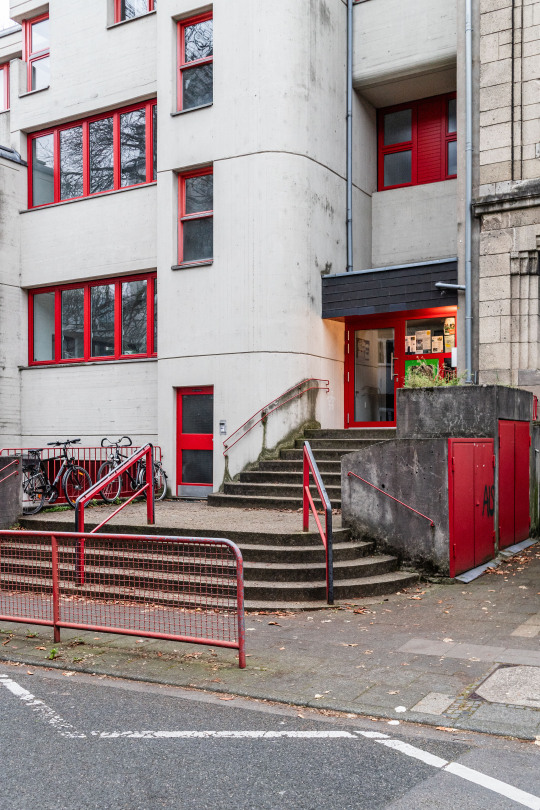

gneisenaustraße // köln nippes
architect: paul georg hopmann
completion: 1974
this brutalist gem, which houses a kindergarten and a community centre, is located in the heart of cologne's nippes district. the striking façade design of pure concrete and red window and door frames, as well as the fragmented structure, make the building a real eye-catcher. the red colouring also extends to the railings, letterboxes and service openings, contributing to the coherent overall impression.
dieses brutalistische kleinod, welches einen kindergarten und ein gemeindezentrum beherbergt, befindet sich mitten in köln nippes. die bemerkenswerte fassadengestaltung von purem beton und roten fenster- und türrahmungen sowie die zergliederte struktur machen das bauwerk zu einem echten hingucker. die rote farbgestaltung erstreckt sich außerdem auf geländer, briefkästen und versorgungsöffnungen, so dass dies zum schlüssigen gesamteindruck beiträgt.
#paul georg hopmann#cologne#moderne#design#köln nipppes#nippes#nbrutalism#brutal archtecture#photography#architecture#germany#architecture photography#urban#nachkriegsmoderne#post war architecture#nachkriegsarchitektur#nachkriegsarchitektur köln#nachkriegsmoderne köln#nachkriegsarchitektur rheinland#nachkriegsarchitektur deutschland#nachkriegsmoderne rheinland#nachkriegsmoderne deutschland#post war modern#german post war modern#german post war architecture#rhineland post war architecture#rhineland post war modern#cologne post war modern#cologne post war architecture
554 notes
·
View notes
Text


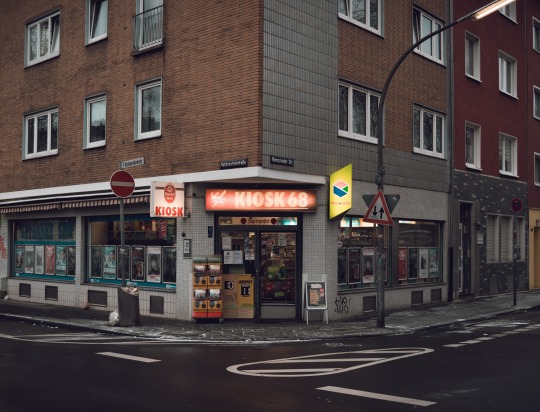
[gamedev:part 5.2]
Worked on some assets. I want to create a scene that has a german core aesthetic—Cologne in specific. (God, I hope this is not a nazi term >.< But … like … the vibe of German cities. A mixture of Gründerzeit houses next, to post-war 50–60 architectural atrocities.). Not sure how well it will translate though. German cities have a lot of similarities amongst each other, while at the same time each district can feel like its own city entirely.
My disctrict has a lot of lefty stickers plastered on every surface. And I wanted to replicate that. I included some stickers friends gave me, as well as some eastereggs. The whole sticker thing is mainly for me, because with these 256x256px textures most of them won’t be readable, and I’m not even sure if there will be a way to look at them in game, as I’m not planning for a moveable camera. We’ll see …
#godot engine#gamedev#indiedev#visual novel#3d game development#screenshot saturday#blender3d#low poly
3 notes
·
View notes
Photo

Fritz Schaller (1904-2002) was one of Germany’s most interesting postwar church architects who created spaces of fascinating purity. Emanuel Gebauer’s dissertation „Fritz Schaller: Der Architekt und sein Beitrag zum Sakralbau im 20. Jahrhundert“, published in 2000 by J.P. Bachem Verlag, is an in-depth study of Schaller’s church architecture that goes way beyond the architect’s postwar work: the author also highlights Schaller’s involvement with the Thing movement during the Third Reich, a movement in which actors and amateurs created dramatic plays in dedicated Thing theaters that were often planned by Schaller. Later the movement was forbidden by the Nazi authorities and Schiller found employment at the Heinkel works. After the war Schaller on request of Rudolf Schwarz got involved with the reconstruction of Cologne, a decisive for the success of his Cologne office. At this point Gebauer starts his very detailed analysis of Schaller’s churches and closely recounts the changing circumstances that shaped their designs: from a late 1940s purity to the complexity of the 1960s and 1970s the author, who conducted hours and hours of interviews with the architect, elaborates Schaller’s deep contemplation of each aspect of a church, especially with regards to the different liturgical zones. Accordingly the post-conciliar designs play with the newly found freedom which resulted in complex, multifocal church architectures. A significant project that Gebauer pays particular attention to is Schaller’s transformation of the area surrounding Cologne Cathedral, an extensive project covering both architecture and urbanism that in the meantime has largely been reversed.
What Gebauer also doesn’t spare out is the architect’s collaboration with artists to create glass walls and liturgical tools, a very interesting aspect and another step towards the church as a total work of art. „Fritz Schaller: Der Architekt und sein Beitrag zum Sakralbau im 20. Jahrhundert“ is a meticulous study of an architect whose profane works still await critical analysis but whose churches with Gebauer’s work already received a more than adequate appreciation.
#fritz schaller#monograph#architecture#germany#religious architecture#german architecture#architectural history#book#architecture book#nachkriegsarchitektur#nachkriegsmoderne
14 notes
·
View notes
Text
Gothitecture
gothitecture: architecture appreciated by goths. -Urban Dictionary
Gothitecture is like pornography. You know it when you see it. The Addams Family mansion, The Munsters’ house, the Psycho house, the Houses of Parliament, and Cologne Cathedral all spring quickly to mind as examples. But it’s also that dark and hyper-modern new cabin in the mountains, or that steampunk tower in that rundown industrial neighborhood, or the ruins of that 500 year old castle on the outskirts of town. Gothic, Victorian, Baroque, Romanesque, Dark Deco, Post-Modern - any and all of these can fall into this delightful architectural sub-genre so beloved by the darkly inclined.
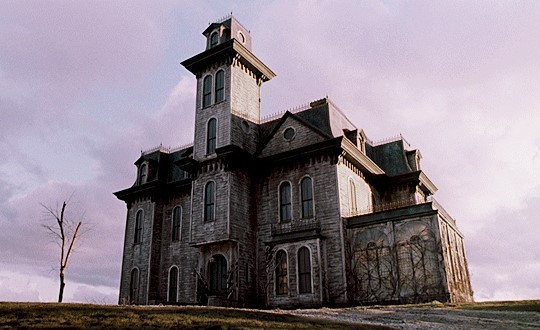
Even as a lad, my eyes would fall upon certain architectural styles and linger upon their lines and sensibilities. They seemed special. They seemed ‘right’. Passing through a neighborhood of cape cods, ranches, and split levels, my eyes would glaze over in disinterest, but as soon as that rare Victorian cottage sprang into view, my mind would jump to life - my eyes drinking up every little detail of the ornate gables, the cast iron fence, the moldings beneath the eaves. These rare beasts seemed to possess a unique quality that made them seem so special. These buildings embodied personality and grace.
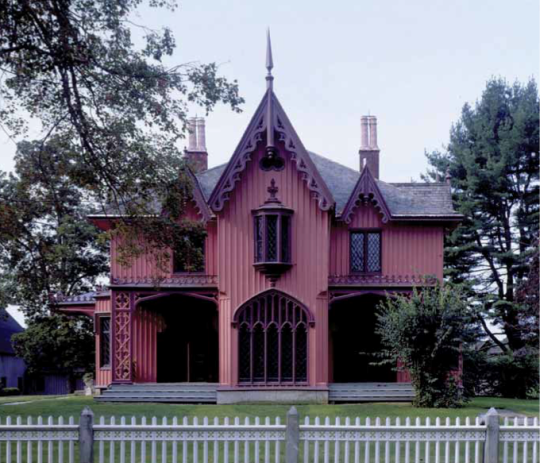
Overly introspective as most goths tend to be, I’ve often wondered as to the origins of this fascination and I may have sussed it out. When I was crazy young, 3 or 4 years of age, my mother was friendly with an old woman who lived in a very modest, yet decidedly Victorian, house. It isn’t quite large enough to be called a mansion, but it’s close. Amazingly, it still stands, although I’m sure the little old lady is long gone. Located in a severely rural area of North Carolina, it lacks the ornate finery of similar homes from even the smallest of towns, but anyone who looks upon it would agree: Victorian.
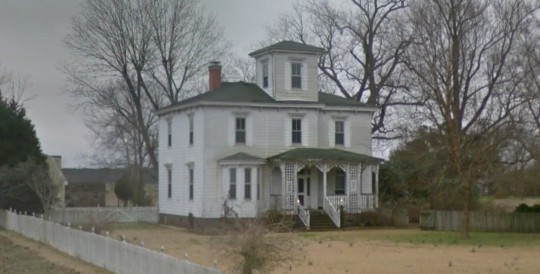
In it’s day, it was likely one of the grander residences of the county, but that day has long passed. To me, it is and always will be special because of the memories that reside within. Visiting the woman who lived there was a special occasion and my mother would make me wear nice clothes and sternly instruct me to be on my best behavior. I was to say, “Yes, ma’am,” or “No, ma’am,” and to otherwise keep my mouth shut. Not the best behaved of children, I was nevertheless happy to comply because of the wonders that hid inside. The house was filled with antique furniture and decor, most of it Victorian vintage. I can still recall being entranced by the a stereoscope viewer complete with image cards from the late 19th century. I remember the intricate crystal candy dish upon the coffee table that held horrid hard candies which might also have been of Victorian vintage. I was obliged to force one down each visit out of politeness, but it was like eating glass. It was worth it because as soon as the women set themselves to the serious business of chit-chat, I was shepherded into a separate room - the room with The Toy Box.

I don’t recall precisely what The Toy Box looked like, but it was large, simple, and painted. Within, were wonders untold. At least 75 years worth of toys lived inside, all in excellent condition and each eager for a child’s attention. My tiny hands fell upon tin soldiers, Jacobs Ladders, hand puppets so old their once heavy cloth was reduced to gossamer wisps, hand carved and painted tigers, horses, elephants, and spring-loaded cannons with accompanying tiny cannon balls. A battered tin Spitfire airplane spoke of the little boy form the war years who ran through the yard holding it high over head so it soared through the clouds. A faded rag-doll recalled the little Edwardian girl who used to hold her close and call her ‘My Dolly’ - it never left that little girl’s side until one day, it did. I’m sorry dolly, I don’t know where your little girl went. Perhaps she’s the old lady in the next room? I seemed to fall into that toy box for weeks at a time, although it was probably less than an hour at a go. Everything seems so much bigger when we’re young, especially time. But not all the toys were happy. There was one that scared me. It was a Jack-in-the-Box.
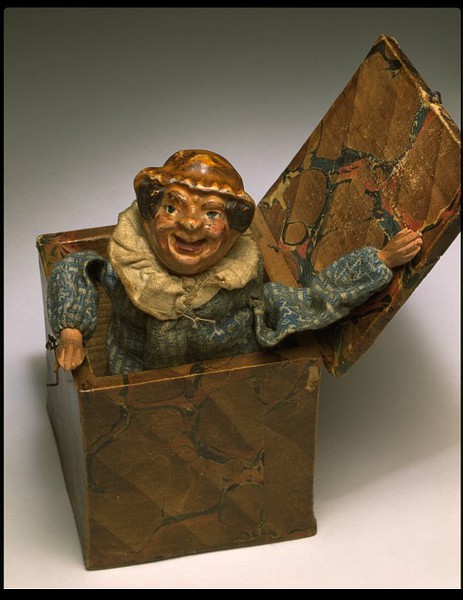
Allow me to clarify: it scared the hell out of me. I don’t know what it was about that thing, but I only ever cycled it once. The music the crank produced was old, sickly, and twisted. The spring rusty and diseased. It didn’t so much pop out as lurch forth. It was a nightmare in a box. I quickly shut it, latched it, and buried it beneath the other toys, but it would continue to make occasional evil sounds whenever I shifted the other toys about. I imagine it’s still there to this day, patiently waiting to terrorize another child. It’s what it does and that’s all it does. But for me, it was an evil contained. I knew it wanted to torment me, but I wouldn’t let it, so I was free to enjoy the wonders of The Toy Box. Such strong memories must carry weight, correct? Is this the reason my eyes linger lovingly on Victorian houses to this day? Perhaps. But what of gothic revival structures, or Romanesque, or Post-Modern? I never spent time inside one of those as a child with a magical toy box. Introspection can sometimes twist into a Shining Maze. Best not to stay too long - you may become frozen inside, forever.

Gothitecture can also spring from a place rather than a form. Take a simple A-frame cabin in a dark wood. We goths do love a good, dark wood. Perhaps a light rain falling from an overcast sky. Ravens caw and circle above. Some forest creature runs by, unseen in the underbrush, but definitely heard - perhaps a wolf? Tendrils of fog drifting across a forest path. As night falls, broken clouds waft past the sickle moon. An owl calls out questions to the shadows beneath the trees. And late into the evening, we gather around a fire pit as the mountain cold wraps about us, and stare into the hypnotic, dancing fire. I’m so there.
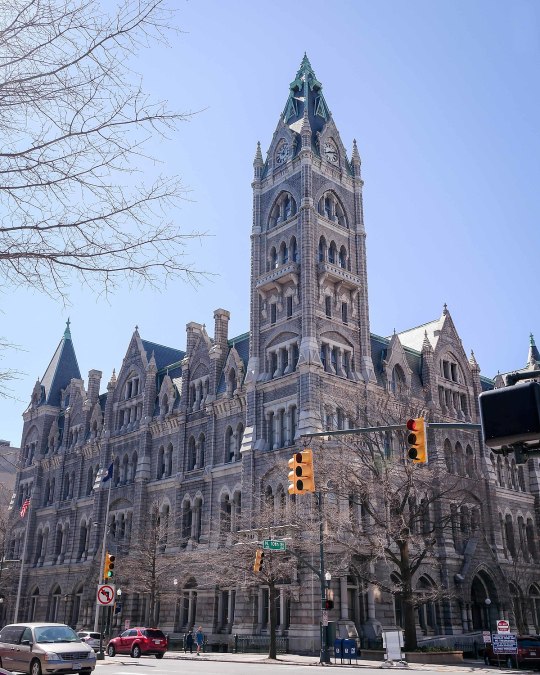
Perhaps we cast our thoughts favorably upon these styles because that’s where we belong and we full well know it. We’re meant to drift about within these halls and upon these grounds. The sounds of our heavy black boots upon stone floors is a thing meant to be. The whisper of long dark coats as they brush across walls is a sound intended. It’s a symbiotic relationship. What’s a Gothic cottage without a goth to reside within? How lonely it must be. Those gargoyles perched upon the gables are not just there to ward off evil spirits, they’re also there to welcome home long lost friends. When you look up at them, give them a friendly smile. They know their kith and kin.
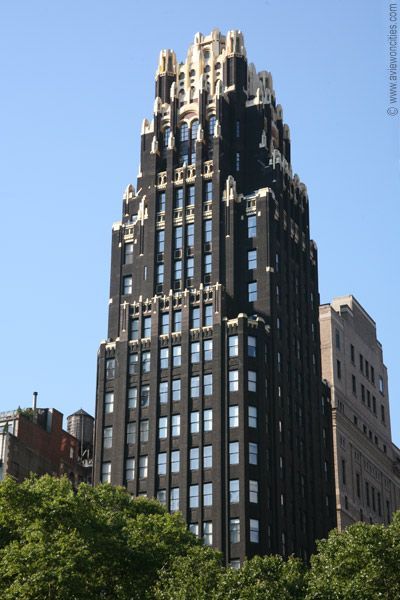
Standing before one of these dark masterworks of space and form, one cannot help but be transfixed, but play the appropriate music to accompany these edifices, and the experience becomes truly profound. Let The Sisters of Mercy, or Switchblade Symphony, or The Damned echo within these halls, and perception becomes sublime. All the pieces fall into place and all is right within our dark world. Goth music was meant to be played within gothitecture while the shadowy forms of goths dance about within. All becomes right with the world.
Perhaps then, even evil toys are lulled into slumber within the forgotten toy boxes of the Counties of Caroline.
creaturesfromelsewhere 12-29-2021
#gothitecture#goth#gothic#dark deco#romanesque#victorian#elder goth#a-frame#post-modern#baroque#musings-from-an-elder-goth#the addams family mansion#the munsters mansion#the psycho house#richmond old city hall#bryant park hotel#the sisters of mercy#switchblade symphony#creaturesfromelsewhere#darkly inclined#spitfire#jack-in-the-box#jacobs ladder#tin soldier#rag-doll#toy box#shining maze#north carolina#the counties of caroline#the damned
22 notes
·
View notes
Text
Watch What Happens - Chapter 4
Chapter links: 1, 2, 3
Summary: Arthur, an aspiring comedian, has struggled to find normalcy and compassion his entire life. Y/N, a hard-working paralegal and transplant to Gotham, has just been put on a case for the Wayne Foundation. When they meet, unexpected sparks fly.
Chapter warning: Swearing
Words: 2,803
A/N: The joke Arthur comes up with in the third part of this chapter doesn’t completely work with a “Y/N,” because it uses the OFC’s name for alliteration. (The OFC version of this fic is posted on AO3.) Sorry!

It was Saturday. Y/N was supposed to have the day off, but she’d spent her Friday night reading parts of the Wayne file. It had been engrossing. From what she’d gathered, the foundation wanted to convert the rent-controlled housing buildings into a medical clinic. The buildings in question had all but been abandoned, the motions claimed, and were in serious disrepair.
The current owner’s response had been lackluster - a counter-motion stating both the addresses in question were up to code and actively being used. But they had neglected to provide more than a couple leases or rental agreements. She wasn’t surprised. The motions were dating back two years. She could imagine the current owner, a family that had had possession of the buildings since the late 1800s, was running out of funds. Their most recent filings were done without a lawyer.
The addresses were about two miles uptown from her apartment. Seeing at least one of them would give her a chance to determine what the actual situation was. And it gave her a good excuse for a brisk walk. She checked the clock as she finished her coffee: 7:13 AM. Good. She hoped it was early enough to visit one of the buildings and look it over without being noticed. She slipped on a thick coat, grabbed her purse and an umbrella, and headed outside.
Gotham was dreary this morning, an unpredictable drizzle. She still wasn’t use to the city’s typical Eastern rain. At least it wasn’t snowing yet - Patricia had told her winter seemed to come earlier every year. This was the one season she missed being further South. The autumn lasted for weeks back home; she’d still be wearing a light jacket.
She eyed the architecture as she walked. It became less decorative the further she went. Gone were the porticoes and fancy facades of the wealthier parts of the city, replaced by simple brick and concrete. There was a brutality in how quick the change was, as if the builders thought people in cheaper apartments couldn’t enjoy aesthetics. Parks and artwork grew rarer, too, until the area was almost totally devoid of public spaces.
Letting out a breath, she approached one of the apartment complexes. The four story building was uncharacteristically stout for Gotham. A tenement covered in graffiti. Walking around it, she lightly inspected the foundation for faults that would be obvious to her layman’s eyes. There were no cracks, no chunks appeared to be missing.
The front door was ajar, held open with a triangular piece of wood. She gingerly pushed it open, trying not to make any noise, and let herself in. The entrance was in some disrepair. Dark green paint peeled in the corners of the lobby, the laminate floor was coming up in some places. The florescent lights were on, though, and the floor was shining. Whoever lived there cared enough to clean the place.
The stairs were solid when she stepped on them, the railing a bit wobbly but sturdy enough to put her weight on it. As she reached the second floor, she wondered where the Wayne Foundation had gotten the idea that this building was abandoned. She walked down the hall, noticing every name plate and personal touch - a postcard of a sunny place here, a wreath there - on the doors.
“Hey, who are you?”
Y/N stopped and turned to the direction the voice had come from. An elderly woman stood there, newspaper in one hand, pink robe being held closed by the other. She looked displeased.
Fuck. Y/N cursed herself, both for being too bold and being too stupid to think about being seen by a tenant. She gave the woman a friendly smile and approached her. “I’m sorry to have bothered you, ma'am. My name is Y/N. I just wanted to see-”
The woman’s face softened. “Oh, you’re not from Renew Corp.?”
Y/N furrowed her brow in confusion. “Renew Corp.?”
“Yeah. They keep harassing us. You hold on a minute.” The woman disappeared for a moment, closing the door.
Y/N sighed and leaned against the wall. She didn’t want to stumble onto anything crazy; she just needed to gather evidence to support the Wayne Foundation’s position. She wanted to do her job and do it well. Rubbing her face, she could already feel a headache coming on. The first Wayne case she was entrusted with, and she was already finding leads she didn’t want to.
God dammit. She knew she wouldn’t be able to let this go.
As soon as the woman returned, Y/N straightened up. “Here you are,” the woman said, handing her the letter. “They keep sending them in these red envelopes. As if that could scare me. I lived through the war.” She laughed to herself.
Y/N couldn’t help but smile back as she read the addressee’s name. After opening the envelope, she scanned the letter. “Ms. McPhee, may I keep this?”
“Go ahead. I’ll get another one in a few days,” Ms. McPhee answered.
Y/N tucked the letter in her purse. “Thank you.”
Ms. McPhee nodded. “Sorry about earlier. We don’t get many visitors here.” She gestured behind here with her thumb. “Do you want to come in for a cup of tea? I have a cat. You’re not allergic, are you?”
Y/N took a step back, placing a hand over her chest. “I’d love to but I have to get going. Would it be alright if I dropped by sometime? Asked a few more questions?” There was a pause. At Ms. McPhee’s expression, Y/N added, “Bring some tea biscuits along?”
That got her.
~~~~~
On the way back to her apartment, while still in Otisburg, Y/N decided to treat herself to breakfast. A couple of diners lined the streets, but food from a greasy spoon wasn’t what she was looking for. A bakery would work; she could get something light and sweet. A donut shop caught her eye. And her nose. She peeked in through the old, warped windows. Lackluster lighting, just enough film on the glass to make her question the place’s health inspection certificate. She’d found her joint.
The row of people waiting against the wall surprised her when she went inside. After a few moments deliberation, she decided to stay, not having concrete plans for the rest of the day. Copies of the Gotham Gazette were piled high, not yet in their display case. Shuffling along as the line moved forward, she grabbed a paper and started reading the headlines: “Thomas Wayne - Will he or won’t he?;” “A New Day for Gotham;” “New Budget Cuts Risk Safety.” God, news like this made her wish she gave less of a shit. She closed the paper and looked up towards the entrance, the bell above the door ringing endlessly as more people poured in.
And there he stood. Good hair, Tan jacket. He was leaning against the wall, seven people down from her. She noticed he was wearing a brown cardigan and button-up shirt. His hair was a little damp, probably from the weather. It didn’t affect his good looks in the slightest.
She hadn’t expected his eyes to dart to hers so quickly.
Heat rose to her cheeks. Dammit, she scolded herself. You’re staring at him again. Leave the man alone, you idiot. She tried to focus on the menu hanging overhead.
That focus failed utterly when she saw him sidle up beside her in her peripheral vision. He stopped about two feet away. As it had at the store, it took him a few moments to speak. “Hi,” he said.
“Hey,” she replied, eyes still averted. “Fancy seeing you again.”
“Yeah.” He looked up at the menu, too, but she wasn’t convinced he was reading it.
She allowed herself a glance at his profile, long enough to realize it was a mistake if she wanted to stop ogling him. She was close enough to see the hint of laugh lines at the corner of his eye, the rounded tip of his nose, that damned jawline. She swallowed and looked down. His hand was worrying his pocket. The tension with which he held himself was obvious. It was hard to figure out if his hesitancy was peculiar or adorable. She decided it was both. “How was your TV dinner?” she asked.
“Fine. They’re always the same. Yours?” His deep voice was slightly raspy when he answered.
She gave a small shrug. “It didn’t kill me.”
The man chuckled at that and flicked his eyes to her for a moment. “Good.” The line moved forward and he stepped with her. “You should get the-”
“Hey, buddy,” a voice from the back bellowed. “You can’t just cut in line.”
The effect on Good hair, Tan jacket was immediate. He stiffened even further, cheeks turning pink, his jaw clenching. He briefly brought his hand to his mouth and winced. As he spoke, softly but loud enough for the asshole in the back to hear, his eyelids fluttered shut. “I wasn’t cutting. I just wanted to say hello.”
The fact that he responded surprised her. She liked it. When he started to turn towards the end of the line, she stepped closer to him. “What do you want? I’m next in line.” When he didn’t answer, she said, “I’ll grab it. It’s no big deal.”
He blinked at her before digging into his pocket and handing her change. "Cinnamon sugar. I was going to suggest you get it. It’s the best one.”
Smiling, she nodded. “Thanks for the recommendation. It’s my first time here.” She extended her hand to him. “I’m Y/N, by the way.”
He looked at her hand before grasping it gently with his. “My name’s Arthur. Arthur Fleck.” The smoothness of his palm was warm on hers, the fingertips of his long fingers resting against the back of her hand. “I’ll wait outside.” With that, he released her and left.
After getting their order, she left the shop to find the morning’s drizzle had turned to a steady rain. Arthur was standing under the shop’s awning, smoking. She thought she’d detected the scent of nicotine. And maybe some cologne. “Here. You got the last cinnamon sugar.” She started to hand him the donut.
He shook his head. “I’ll take the other.”
“I hope you like chocolate.” Y/N gave him the small wax paper bag. “Can you tell me where the nearest subway is? I need to head home.”
“Newkirk Plaza.” His brows knit together and he looked down as he took a long drag off his cigarette. “I could walk you there?”
She noticed he’d said it quickly, as if he didn’t want to lose courage. She took the umbrella from inside her coat and opened it, then stuck her arm out so he’d have room to share it. “Sure. That’d be great.”
“Yeah?” He laughed softly, surprise on his face. “Okay.” Cautiously, but with some eagerness, he stepped under her umbrella. He seemed to hold his breath as they started walking in the direction of the train station.
They strolled in companionable silence. As each block ended and another began, she found herself wishing he would talk. He’d invited her on the walk, after all. Maybe she could bring him out. “Have you in lived in Gotham long?”
He flicked his cigarette on the ground and let out a small huff. “All my life.”
“You’re a real Gothamite, then. I’m a transplant. Moved here about a year and half ago.”
“Oh yeah? Where from?”
“Boonville, Missouri.” Waving her hand dismissively, she continued. “Trust me. You’ve never heard of it.”
He looked at her, studying her face for a moment. “You don’t have an accent,” he said.
Y/N rolled her eyes. “That’s intentional.” She adjusted the umbrella in her hand. “I made sure to lose it as a kid. When I eventually moved away, I didn’t want to be out of place. It’s nice to be anonymous.”
Arthur took out another smoke and placed it between his lips. “But why come here? It’s so cold. People are mean. The garbage strikes…” He lit his cigarette. “It’s rough.”
“Believe me. Small towns have their own problems. They’re just not as visible. And everyone knows each other. God, it’s disgusting.” She laughed, then. “No, I really love it here. Best decision I’ve ever made.”
He shook his head, the corner of his mouth rising. “Hm.”
When the sign for Newkirk Plaza was in view, his steps slowed. Y/N noticed. He must have enjoyed walking with her. She liked it, too, which felt odd, since he was a stranger. Odd but good.
Arthur stopped as they reached the entrance to the station. He looked away from her and down the stairwell, as if what bit of confidence he had was ebbing. “If you go down these stairs, you can pick which line you want.”
Y/N nodded and smiled. “Thanks for the stroll, Arthur.”
“Yeah.” After a few beats of silence, he gazed back up at her. “You know, I do stand-up comedy?”
She looked at him in disbelief. This guy? This bashful guy got up on stage in front of people? “Really?”
“Maybe you could come see a show sometime,” he said.
She studied him for a few moments. The slight puffiness under his eyes, the tiredness in his face. The way he stood there, waiting for her reply with cautious hope, gave him an air of quiet fragility. Even though she was intrigued by him, she wasn’t ready to give her personal information out. Not yet. She wracked her brain, trying to think of a kind but honest answer. “Well, my job is going to be bringing me to this area again soon. When we see each other, you can tell me when and where, okay?”
He smiled slightly at the non-committal response. “All right.”
Y/N tried to hand him the umbrella. “I suspect you have a ways to walk.”
He put his hand up, then pulled the hood on his jacket over his head. “It’s okay, I just live over on Anderson.”
“Oh, okay.” She cleared her throat. “Well, I’ve gotta go. See you around, Arthur." She started down the stairs, then turned to him again, blushing lightly as she met his eyes. “Thanks for the donut, too.”
~~~~~
Arthur felt like he could take on the world (or at least Gotham City). The nice woman from the store had somehow wound up in his nearby donut shop. He’d said hello. They’d gone for a walk. Shared an umbrella. Had a conversation. He hadn’t fucked up.
When at the train station, he’d been tempted to follow her, not wanting to lose the connection they’d had. But he’d trailed his neighbor, Sophie, to work one time in a pathetic attempt to ask her out. He hadn’t worked up the nerve to do it by the time they’d reached Sophie’s place of employment, so he’d turned around. That evening, she had knocked on his door and explained, with more kindness than he deserved, that he’d alarmed her and following her was inappropriate. Even though he had been embarrassed, he appreciated her taking the time to spell it out for him.
He was determined not to do something that stupid with Y/N.
Sophie. Y/N. What was it with woman with (Y first initial) names? They’re both saucy and sweet. Laughing lightly, he exited the elevator and headed towards his apartment.
“Mom, I’m back.” After hanging his jacket, he put the donut on a small plate and cut it into bite-sized pieces. That would make it easier for Penny to eat. He poured her a cup of coffee and headed into the living room.
His mother was asleep in the easy chair. “Good Morning Gotham” was playing on the TV. Arthur approached her gently and shook her shoulder. Her eyes slowly opened. It took a few seconds for her to focus on him. “Oh, Happy, did you check the mail?”
“It’s too early. The mail hasn’t come yet.” He put the plate in her hands. “Here. Eat this. I’m going to do laundry. I’ll be in the basement.”
She kept her eyes on the television when she gave her delayed answer. “Okay, Happy.”
Arthur stepped by her, basket in hand. On the way out, he grabbed his pen and journal. Once the laundry was on, he sat in a chair across from the machine and opened the worn notebook across his lap.
He thought of Y/N for a while, then his upcoming job at the children’s hospital on Wednesday. He’d been practicing his magic tricks, but would end with a dance. He loved working there. The kids were always so happy to meet Carnival the Clown. Maybe the upcoming week would be decent. A little kinder than most.
Tag list (Let me know if you want to be added!): @harmonioussolve @clowndaddyfleck @stephieraptorr
#arthur fleck#arthur fleck x reader#arthur fleck x female reader#arthur fleck fanfic#arthur fleck x ofc#joker 2019#watchwhathappens
70 notes
·
View notes
Text
Fwd: Graduate position: CologneU.EvolutionaryGeneticsFloodplainSpecies
Begin forwarded message: > From: [email protected] > Subject: Graduate position: CologneU.EvolutionaryGeneticsFloodplainSpecies > Date: 15 February 2020 at 06:32:54 GMT > To: [email protected] > > > A PhD position is available in the research group of Prof. Juliette de > Meaux at the University of Cologne. The PhD student will investigate the > Genetics of Arabis Floodplain Species. > > The lab has recently discovered that the closely related species Arabis > nemorensis, A. sagittata and A. hirsuta are all present in floodplain > meadows along the Rhine, Danube and Elb rivers. Phenotypic studies have > shown that these species differ in various traits affecting their > ability to cope with abiotic stress and competition. For this project, > the PhD candidate will use quantitative genetics and transcriptomics > approaches to determine the genetic basis of these differences. The PhD > candidate will acquire a broad array of skills ranging from genomics to > molecular genetics and ecology, and develop a solid basis in data > management and analysis. > > The applicant must hold a Master degree in Biology (or Bioinformatics) > and prove interest in plant molecular, population or ecological > genetics. Experience in plant stress physiology or statistical analysis > of quantitative data is welcome. This position is open to applicants of > all nationalities but the usual language in the lab is English. > Applications or questions regarding the position should be sent by mail > to [email protected], with the following subject line – PhD > application Floodplain species – de Meaux lab. A letter of motivation, a > CV and the contact to at least 2 referees should be provided, all in a > single pdf file. Revision of applications will begin immediately and > continue until the position is filled. Funding is for 3-4 years starting > at earliest convenience. For more information on our lab and research > visit our website https://ift.tt/2OqstBD Interested > students currently completing their Master thesis are encouraged to > informally contact the PI because the starting date can be adjusted. > > Cologne is Germany’s vibrant Metropolis on the Rhine. The city is well > known for its wild carnival, its famous Kölsch beer, its Cathedral and > its vivid contemporary art and musical scene. Cologne is the fourth > biggest city in Germany with over a million inhabitants from all over > the world and an interesting mix of restored historic buildings and > modern post-war architecture. Most importantly, Cologne University is > one of the oldest and largest Universities in the Country. Our research > group is hosted at the Biological Center of the University of Cologne > and associated to the Excellence Research Cluster CEPLAS > (http://ceplas.eu/de/), which fosters active interactions between plant > scientists of the Universities of Cologne, Düsseldorf and the Max Planck > Institute of Plant Breeding Research. In this context, our PhD students > are assured to start their scientific career in a world-class scientific > environment. > > Juliette de Meaux > via IFTTT
1 note
·
View note
Text
Top 8 Places to visit in Germany
Introduction
Germany is a beautiful country for tourism. The Rhine Gorge, Berlin, Munich, Frankfurt, and Hamburg are some of the most popular places to visit in Germany.

Germany is a beautiful country for tourism
• Germany is a beautiful country for tourism. • There are many tourist places in Germany to visit. • It's very safe for tourists to come here and enjoy their vacations, as there are no wars or terrorist attacks in the country. • There are many attractions that tourists can go see when they come here, such as museums, castles, and palaces.
Rhine Gorge
The Rhine Gorge is a canyon formed by the River Rhine. It is located in the state of North Rhine-Westphalia, Germany, between Bingen and Bonn. The Rhine Gorge forms part of one of Europe's largest UNESCO World Heritage Sites: Rhineland-Pfalz/Saarland with its regionally abundant cultural heritage and natural richness. Remember that one can get into the country if they only have Germany Visitor Visa.
Berlin
Berlin is the capital city of Germany and has a population of 3.35 million people. It's also the second most populous city in Germany, with a population density of 3,500 people per square kilometer. The first time I visited Berlin was when I was 13 years old, so it wasn't until recently that I got back there again as an adult and saw how much it had changed since my childhood memories.
Munich
Munich is the capital of Bavaria and one of the most important cities in Germany. With its rich cultural heritage, Munich is a city you should visit at least once in your life.The main tourist attractions include museums such as Deutsches Museum, Lenbachhaus and Alte Pinakothek; landmarks like Marienplatz Square and Hofbr�uhaus brewery; parks like Englischer Garten Park or Olympic Stadium Park; churches like Frauenkirche Cathedral or St Peter's Church (St Peterskirche). (Read More: Top 5 attractive things about Germany)
Frankfurt
Frankfurt is the largest city in the German state of Hesse and the fifth-largest city in Germany. It is known for its financial district, called Bankenviertel (Banking District), with many high-rise buildings such as Messeturm (Exhibition Tower), Westendstrae and Taunusanlage.
Hamburg
With 1.8 million residents, Hamburg is the second-largest city in Germany. It is also one of the most important ports in Europe and has been dubbed "the gateway to Europe".
The city's history dates back to its founding as a small trading post by Vikings more than 1,000 years ago. Hamburg later became part of the Hanseatic League (Hansa), an alliance between trading cities that controlled trade along sea routes from Scandinavia to Central Europe. (Read More: The easiest ways to immigrate to Germany)
Nuremberg
In the Middle Franconia administrative region of the German state of Bavaria, Nuremberg is a city. It is situated along the Rhine-Main-Danube Canal and the Pegnitz River. Nuremberg was one of the great European cities of the Middle Ages because of its importance in trade and commerce as well as its being an imperial city (Kaiserpfalz).
Dresden
Dresden is the capital of Saxony and one of Germany's most popular tourist destinations. The city has a lot of history, with its Baroque architecture being famous around the world. It's also home to many museums and galleries, which makes it a great place for history buffs to visit.
Cologne/Bonn
Cologne is the fourth largest city in Germany, with a population of over 1 million people. Travel to Cologne, Germany to witness the beauty of the Rhine River, which runs through the city center and divides it into two parts: Rheinauhafen (right bank) and Innenstadt (left bank).
Conclusion
Germany is a beautiful country for tourism. It has many places to visit, from Rhine Gorge to Berlin and Munich. If you are planning a trip to Germany, then make sure that you visit these eight cities as well.
0 notes
Photo

Painter SEAK Claus Winkler: dipped in to carneval. nuance compared to my 20s, teens/ childhood. pasta/ pizza (carbs). 3 glasses redwine. No beer ( Kölsch), calories, nasty hangoverish post day feeling. The street carnival trains belong to my childhood memories. Some liberated good vibes after all the reality cold showers the last year from our new poc migrants. Bringing deadly medieval blade violence back for here to stay. Forcing us german man, to man up, hold our heads up, addapt accordingly. Was although good seeing women with in a attractive appropriate age ( 18-24 years). Although lots of natural non tattooed (❤️👍) 8s,9s,10s, where lining up in sight, though below 18 years (legal age in Germany), a no. ☹️. In general, less costumes, less people, less native slang, less decorated Waggons 🙁. healthy for my psyche mingling, joining the good vibes. With all the toxic left woke nonsense, poc on caucasians/ native deadly violence & cultural/ genetic cucking it’s is necessary standing by your native culture ( in my case: german/ north european , Rhineland, austrian, english, eastprussian/ pommerian) supporting, loving, living it. In German i would have written this different. language = vibe. A shame i speak so less cologne slang ( Kölsch/ rheinisch/ buure platt ( Farmer/ Rural suburbian Slang).the industrial Rhineland ugly. Industry investment architecture + late war allied carpet bombing leveling out anything architectural beautiful with culture identity. Carnival, with the 1000 year tradition, a way to comprehend that reality. a stepping stone, which inspired me being creative, being a painter. My first carnival expierences are where my studio is. Carnival was although always good seeing attractive females with in my teens. ( like profiles/ insta). #collectiblesciencefiction #midcenturymodern #redpillbased #basedredpilled #luxurycondos #artconsultants #billionaireslife #SEAK #billionaireboysclub #ClausWinkler #billionairelife #billionairelifestyles #collectionneursdarts #collectionneursprivés #redpilled #SEAKClausWinkler #oilpaintingartists #autism #curatorseye #mgtow #artistprocess #homelux #manosphere (hier: Köln, Germany) https://www.instagram.com/p/Co4NZ8EIz2d/?igshid=NGJjMDIxMWI=
#collectiblesciencefiction#midcenturymodern#redpillbased#basedredpilled#luxurycondos#artconsultants#billionaireslife#seak#billionaireboysclub#clauswinkler#billionairelife#billionairelifestyles#collectionneursdarts#collectionneursprivés#redpilled#seakclauswinkler#oilpaintingartists#autism#curatorseye#mgtow#artistprocess#homelux#manosphere
0 notes
Photo
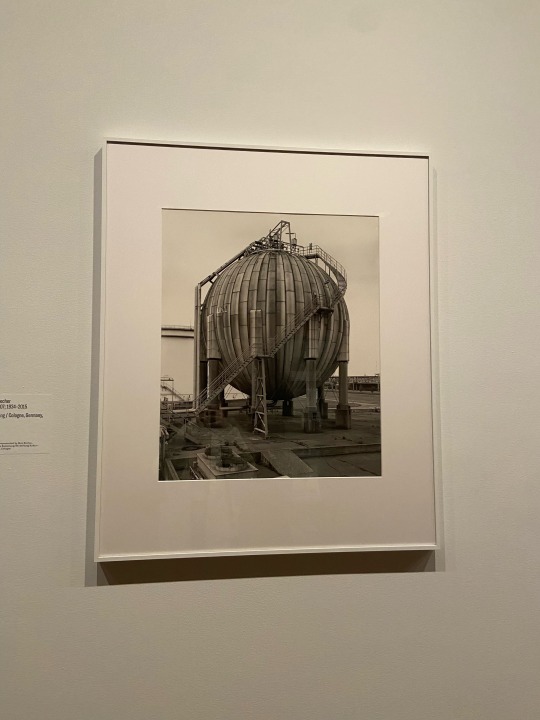
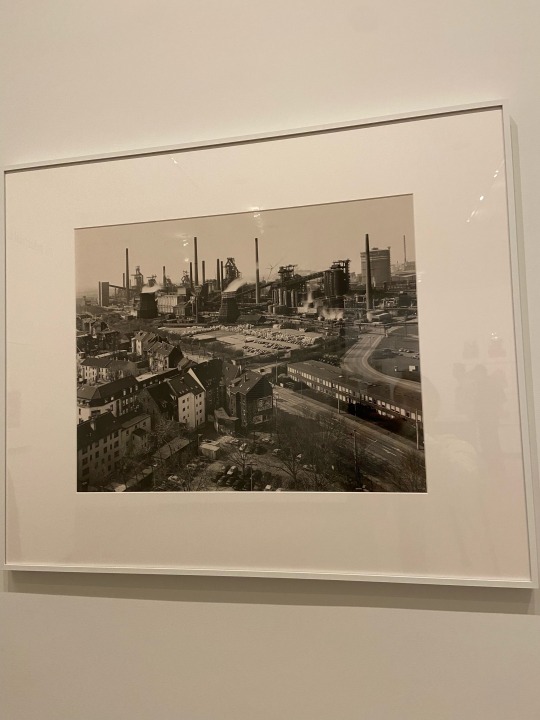
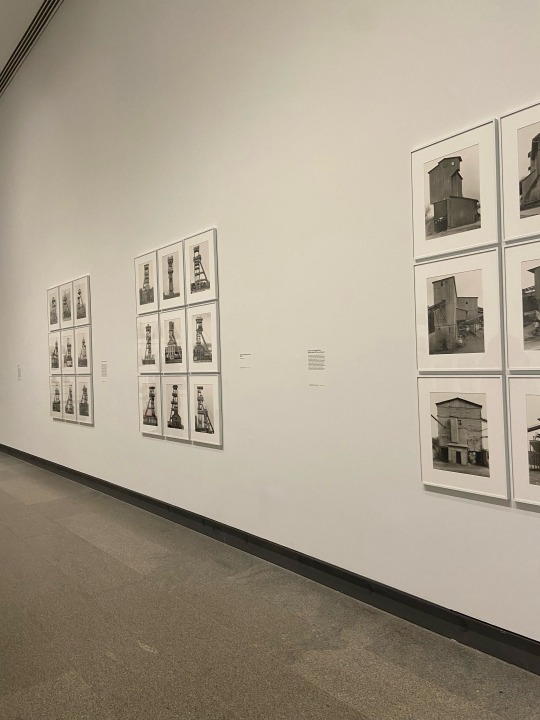
The exhibition that I visited was located at the Metropolitan Museum of Art and is called Bernd and Hilla Becher. In this exhibition, there are approximately 450 beautiful black and white photos ranging from the mid-1900s to the early 2000s all photographed by a couple; Bernd Becher and Hilla Becher. Throughout the exhibit, all these photos are divided into 7 sections. Starting with basic forms (00) and ending with typologies (06.) this takes you on a journey through their career, explaining how their photography style was built. Most of the photos they took were in Germany or Belgium. However, I noticed while walking throughout the exhibit that all the photos, despite the differences in where they were taken, had many uncanny similarities that made you wonder if it was intentional or not. Their focus in taking the kind of photos they did, was to capture the disappearing industrial architecture in these European countries. They photographed old water towers and gas tanks, framework houses, and industrial landscapes. A lot of these looked old, and abandoned, which told the story of how they were slowly becoming less and less needed. All these photos vary a bit in dimension. For example, their water tower photos from the Typologies, section, are about 70 x 70 centimeters, while the framework houses photos are about 60x 60 centimeters. The framework houses especially stood out to me from a technical standpoint: In this section. They experimented with a 360-degree circumnavigation of one structure. When pairing this single enlargement, with its 9 other examples, gave it a more conceptual feel. The exhibition took you through a period of time in the post-war era, allowing you to focus on the western European and north American world from an industrial standpoint.
The two photos that I chose from this exhibition are Duisburg-Bruckhausen, Ruhr Region, taken in Germany, 199, and Gas Tank, Wessling/ Cologne Germany, 1983.
Both photos are gelatin silver prints, which is a style of black-and-white photography. I feel that having these photos in black and white makes much more sense than it would to have them in color. The black and white add more depth to the photo. The first photo in particular captures an industrial landscape from an elevated standpoint. This industrial complex is live and active. There are workers seen in the distance, smoke rising from some of the plants and cars in the parking lot. The elevated vantage point adds to the scale of the photo. It shows the size of the industrial complex itself. It makes all the workers and cars seem so small, and all the plants and buildings so much larger. I feel that this plays an important role in adding to the emphasis of what these photos truly stand for. How the industrial world, architecture, and everything that it has offered to the world is slowly disappearing despite how big and how important they once were. Although this plant is active, it’s still a photo taken place in a post-war time, where very soon its activity will be faded. In the second photo of the gas tank, I feel proportion is an essential part of this photo. The gas tank is the main subject of the photo it takes up nearly the entire surface. Because of this, it is put into perspective the size, and importance of this gas tank. There’s a ladder that wraps around the side, which looks so small in comparison to the gas tank itself due to the proportions of this photo if this photos angle was changed maybe if the gas tank was off to the side, it would not be the main subject of the photo, therefore, the importance that is captured would not be portrayed. In both photos, the lack of color I feel is so important. The whole idea of this exhibition was to show industrial landscapes in a state of disappearance. The black and white adds a sad past-like feel to these photos and really emphasizes the point of capturing these photos.
0 notes
Text

soester weg // köln mehrheim
classic abstract door design of the post-war period.
klassisch abstrakte türengestaltung der nachkriegszeit.
#photography#architecture#design#cologne#köln#köln mehrheim#architecture photography#modern door design#germany#rhineland#nachkriegsarchitektur#nachkriegsarchitektur köln#nachkriegsarchitektur rheinland#nachkriegsarchitektur deutschland#german post war architecture#cologne post war architecture#rhineland post war architecture#urban#urban photography
134 notes
·
View notes
Text
Confidential War Diary of 18th CANADIAN BATTALION – 2nd CANADIAN DIVISION
From 1st December, 1918 to 31th December, 1918
Volume 40 With appendices 1 – 30
Place Date Hour Summary of Events and Information Maps for reference: Marche 9, Germany 1 M, 1 L, 2 L. 1/160,000 attached. Appendix No. 27. 28. 29, and 30. Mean- 23.05.40. Marche 9 1 The Battalion moved in full marching order 08.00 Hrs. for VILLERS STE. GERTRUDE, the usual noonday halt was made for dinner. From the Noon Hour on the country became rolling, and hilly and very heavily wooded. The Battalion arrived at the destination at 15:00 Hours. Capt. T.H.C. Rayward, and batman returned from Instructor’s Course at Senior Officer’s School, Aldershot, England. 1 O.R. to hospital. 1 O.R. from leave. Appendix No. 1. Villers Ste. Gertrude. 2-G.95.35 Marche 9 2 Battalion resting in billets. 12 O.R’s on leave and 2 O.R’s returned from leave. 3 O.R’s to Hospital and 1 O.R. returned from Hospital. 3 Battalion resting in Billets awaiting move order. 2 O.R’s to hospital. 4 The Battalion moved in full marching order at 08:30 Hours and marched via GRAND MONIL to ODEIGNE. It rained practically during the entire march of the day. A noonday halt for dinner was made, the Battalion arriving at its destination at 16:00 Hours. The march to-day was stedily [sic] uphill into the heart of the Ardenne Mountains. Lieut. R.E. Rouse and 2 O.R’s from leave and 2 O.R’s to Hospital. Appendix No. 2. Odeigne 3-I 20.10 Marche 9 5 The Battalion moved off at 08:30 Hours in full marching order for COUTRIL, dropping down the latter part of the march into open country. Battalion arrived at its destination at 15:00 Hours. 2 O.R’s to Hospital. Appendix No. 3. COUTRIL 4-K 98.60 6 The Battalion moved off at 08:00 Hours in full marching order for WALL RODE, Germany, crossing the Frontier shortly after 10:00 Hours, and passing through St. Vith about 14:30 Hours, arrived at destination at 16:00 Hours. 8 O.R’s from leave and 3 O.R’s to hospital. Appendix No. 4. WALLERODE 5-C 90.35 Germany 1-M 7 The Battalion moved off at 08:30 Hours for MANDERFELD, arriving there at 15:30 Hours. The country roundabout assuming more of an agricultural aspect. 1 O.R. to Hospital and 2 O.R’s returned from Hospital. MANDERFELD 4-H 60.10 Germany 1-M 8 Battalion resting in billets. Capt. R.R. Hartry and 7 O.R. from leave. 2 O.R’s to Hospital. MANDERFELD 4-H 60.10 Germany 1-M 9 The Battalion moved off at 08:30 Hours for DAHLEM, arriving at destination at 16:00 Hours. The Battalion Headquarters being located in the Post Office. 1 O.R. from leave and 1 O.R. on Course. Appendix No. 6. DAHLEM 3-K 60.45 Germany 1-M 10 The Battalion moved off in fighting order at 08:30 Hours and marched to MUNSTEREIFEL, arriving at destination at 15:00 Hours. Lories provided by Brigade, carrying the Men’s packs. The Battalion was billeted in a Boy’s Boarding School. Appendix No. 7. MUNSTEREIFEL Germany 1-L 11 The Battalion moved at 08:30 Hours in fighting order, and marched to KUCHENHEIM, arriving at destination at 13:30 Hours. The Battalion Headquarters being located in the Burgomeister’s house. 18 O.R’s from leave 1 O.R. to hospital and 1 O.R. returned from Hospital. Appendix No. 8. KUCHENHEIM Germany 1-L 12 The Battalion moved in fighting order at 08:30 Hours and marched to DUISDORF, arriving at 12:00 Hours. 2 O.R’s from leave and 1 O.R. to Hospital. 1 C.S.M. and 11 O.R’s [to] 2nd Divisional Headquarters, Bonn, for Guard Duty. Appendix No. 9. DUISDORF Germany 2-L 7 D 35.40 13 The Battalion moved off in full marching order at 08:00 Hours and marched via Bonn, crossing the famous RIVER RHINE at that point to its final destination in the town of Hennef (Sieg). In passing through Bonn the Battalion marched with rifles at the slope and bayonets fixed and passed in review at the east end of the Bonn Bridge, before the Corps and Divisional Commanders. Lieut.-General A.W. Currie, Corps Commander, taking the salute. Maj.-Gen. H.E. Burstall, Commander of the Division, and the Divisional Staff being immediately in the rear of Lieut.-Gen. Currie on the reviewing stand. Upon the arrival of the Battalion in Hennef, 13:30 Hours, Batt’n. Hdqr’s was located in the office of a manufacturing establishment on Frankfurter Strasse, and Hdqr’s officers were billeted in a large Chateau nearby. The Men of “A”, “C” and “d” and Hdqr’s Companies were assigned to billets they were to occupy during their stay in the area. These billets being in private homes of the civilian population. “D” Company proceeded without delay to the village of Happershass, where they were to be on duty as Outpost Company. 3 O.R’s from lave. Appendix No. 10. HENNEF 6 G 90.80 Germany 2-L 14 On this second day of the stay of the Battalion in this are the Officers and men rested in their billets, recovering in a measure from the hardships of the march. Conforming with Army Orders issued to the Burgomeister and from him to the population in general, many civilians have reported to Batt’n. Hdqr’s. for the necessary Identification Passes for use in the local area. These passes being a description of the holder and having further, his or her photograph attached thereto. Several men of the Battn. having knowledge of the German Language, have been selected for Batt’n. duty as Interpreters, etc. 1 O.R. on Hand Compositors Course. 5 O.R’s from leave. 2 O.R. Canadian Corps Cyclists returned to their unit. 2 O.R’s to Hospital. 15 The Battalion formed up on parade and marched though the town to a theatre, in which nothing in the way of amusement was presented for quite some time, and in which the Battalion now held Church Service. The Padre, being in fine form, gave the Battalion an excellent sermon, which was thoroughly appreciated by all members of the Batt’n. present. 1 O.R. to Brigade Duty as Paymaster’s Clerk. Appendix No. 11 attached. 16 The Battalion carried on with training, as per syllabi attached. Between “A” and “D” Companies’ billeting areas a fine large field was located and it served as an excellent Drill Square or Parade Ground. 1 O.R. to Hospital. Appendix No. 12. 17 Battalion Headquarters Staff and Company moved today to the village of Allner, locating the Battalion Orderly Room in a magnificent large Castle, or as termed in the German tongue, Schloss. The Schloss is a huge and very fine specimen of Architectural Art of an earlier period, and is built entirely of stone. Its is surrounded by a beautiful park. When one has seen the Castle and Grounds he is immediately struck with the thought that it is emblematic of the utmost in luxury and convenience. The Batt’n. Headquarters Officers have appropriated the entire Castle and appurtenances for their quarters, having installed themselves in the Sleeping Chambers and using the Breakfast Rooms, Dining Rooms, Drawing Rooms, Billiard Rooms, etc. at their will. The Castle maintains a large staff of servants and consequently the order of the house is of the finest and our Officers are living, as is their due, in every luxury. In a large forest in the rear of the Castle Grounds Dear [sic] and small game abound and the Officers of the Battalion secure a great measure of enjoyment from their hunting and shooting expeditions. The remainder of the Battalion remain in Hennef and are continuing with their training as per syllabi attached. 6 O.R’s from leave. 1 O.R. to Hospital. Appendix No. 13. Allner 6 G 90.80 Germany 2-L 18 The Men of the Battalion have now fully recovered from the hardships of the march and are training as per Syllabi attached. The spirit of the men is superb and they are entering into the daily routine of their stay here and are carrying on their various duties with an eagerness and willingness that is proverbial with the Canadians as a whole. Clothing parades are being held almost daily and the various Company Quartermasters are as rapidly as possible fitting the men with the required new clothing so that the Battalion has now approached the appearance of smartness that is second to none in the allied Armies and in the Canadian and British Armies in particular. 1 O.R. to Hospital. Appendix No. 14. 19 The Battalion continued their training as per syllabi attached. Lieut. S.G. Stokes and 4 O.R’s on leave. Appendix No. 15. 20 “B” Company moved to-day to Brel to continue their duty as Outpost Company there. The remainder of the Battalion continuing their training per Syllabi attached. 3 O.R’s on leave. Appendix No. 16. 21 The Battalion continues training as per Syllabi attached. 4 O.R’s on leave, 1 O.R. to Hospital. Appendix No. 17. 22 The Battalion attended Church Service to-day and enjoyed an excellent sermon, the Padre being in his usual good voice. Major J.J. Richardson and 3 O.R’s on leave. 2 O.R’s attached to Battalion as interpreters. Appendix No. 18. 23 The Battalion continued training as per Syllabi attached, and are maintaining duties in control of the area in the following manner:-
Duties of Commandant and Town Major combined in towns of Hennef (North of Railway), ALLNER, Happerschloss, Heisterschloss, Brehl, Mushmuchl and Weldergoven, in the person O.C. Battalion occupying this district. Headquarters at Schloss in Allner. One H.Q. Officer has office at Hennef permanently for purpose of stamping identification cards. District Administration is carried on by the Battalion Administration through the Burgomeister. No civilians are employed.
One Railway Control Post on broad gauge Railway station at Hennef, which has phone connection to Inter-Allied Railway Commission at Cologne. On the outpost line we have two main Control posts, four subsidiary posts and tow patrols, reference map Germany 2-L.
No. 1 Post (subsidiary) at railroad bridge under V. in Weldergoven.
No. 2 Post (subsidiary) on dirt road just east of village of Weldergoven, just above N. in Weldergoven.
No. 3 Post (subsidiary) on bridge over river where Hennef road joins Allner road. Directly above W. in Weldergoven.
No. 4 Post (Main Control) on bridge in Muschnuehl road, directly below M. in Muschnuehl.
No. 5 Post (subsidiary) on foot bridge S.E. of village of Brehl halfway between l. in Brehl and T in Triesch.
No. 6 Post (Main Control) on bridge where main road Winterschield crosses river.
No. 1 Patrol covers ground between No. 4 and No. 5 Posts.
No. 2 Patrol covers ground along river from junction main Winterschield road with main Brehl-Schied Road.
Traffic with Neutral territory only through main control posts.
Subsidiary posts to guard bridges and prevent traffic to foot paths etc.
No. 377223 Pte. Bihl W. (193 Labour Co’y) and No. 3108760 Pte. Wieber J. (11th Co’y Cdn. Forestry Corps) are attached from 4th C.I.B. as interpreters at Railway Control Post. We have no F.(b) Police attached.
3 O.R’s on leave and 3 O.R’s returned from leave. 5 O.R’s attached to 2nd Divisional Train. 1 O.R. to Hospital. Appendix No. 19.
24 The Battalion continued training as per Syllabi attached. 4 O.R’s on leave and 2 O.R’s returned. Appendix No. 20. 25 “‘A MERRY CHRISTMAS TO ALL’. Christmas Day dawned bright and clear, with just a touch of snow upon the ground, which gave the vicinity a very “Christmas-like” appearance.
The members of the Battalion were in excellent spirit and thoroughly prepared for anything the day might bring forth. The Officers of the Battalion made every preparation for a fine Christmas Dinner and the men were awaiting it with very keen anticipation. At the appointed hour the tables in the different Company mess-rooms, especially selected for the day, were teeming with good things to eat, and they assuredly presented a most pleasant sight.
“A” Company Mess-room was located in a large hall in the Northern section of the town. “C” Company enjoyed its dinner in a very picturesque theatre in the centre of the town, while “D” Company had theirs in one of the schools the town affords. “B” Company being on duty as Outpost Company, had arranged to have dinner in one of the schools in the village of Brohl.
Each of the mess-rooms was decorated in a most pleasant and “Christmas-like” style and tended to heighten the then very high spirit of the men. The tables were loaded with Apples, Oranges, Nuts, Ginger-ale, Cakes, etc. and from the serving tables in the rear came the most appetizing odours of Turkey, meats, vegetables, Christmas Plum Pudding and other items to be served as the dinner progressed.
The men took their places at the tables in a very business-like manner, the different platoons being kept together, and then began what was their first Christmas dinner and also, in all probability their last one in German Territory.
Lt.-Col. L.E. Jones and ad Staff Officers and the Officers of the different Companies were in attendance at each of the dinners of the Companies and during the progress of the dinner Lt.-Col. Jones made a short [entered in pencil] speech of good will, wishing the members of the Battalion a “Very Merry Christmas” and every prosperity for the coming year, which as he remarked would be the one year that would never be forgotten by any one present or by the world in its entirety, being the Anniversary year of the Ending of the War. He again complimented the members of the Battalion upon their share of the conflict and expressed himself as being more than pleased with their conduct in the past and present.
At the close of his address the men express their appreciation of his remarks by rising and giving him three of the most hearty cheers and a “Tiger”.
At the close of the dinner the faces of the men showed, very glowingly, their entire satisfaction. Altogether the occasion was carried off in an excellent manner and it will be one that will never be forgotten by any of the members of this battalion.
2 O.R.s on leave and 3 O.R.s returned.
26 The Battalion continued training as per Syllabi attached. 4 O.R’s on leave and 1 O.R. returned. 1 O.R. to Hospital. Appendix No. 21. 27 The Battalion continued training as per Syllabi attached. 3 O.R’s on leave and 24 O.R’s returned. 4 O.R’s attached to Repatriated Prisoners of War Camp, Wahm. 1 O.R. attached as reinforcement. 2 O.R’s to Hospital. Appendix No. 22. 28 The Battalion continued training as per Syllabi attached. Lieut. C.D. Smith and 4 O.R’s on leave. Appendix No. 23. 29 The Battalion attended Church Service and enjoyed another of the Padre’s excellent Sermons. Capt. C.H. Boulden and Capt. W.A.S. Porter and 5 O.R’s on leave, and 1 O.R. returned. 1 O.R. to Fitters Course at Duran. 1 O.R. to Hospital. Appendix No. 24. 30 The Battalion continued training as per Syllabi attached. 1 O.R. on leave to Paris and 1 O.R. returned from leave, from United Kingdom. 1 O.R. returned from Hospital Appendix no 25. 31 The Battalion continued training as per Syllabi attached. 4 O.R’s on leave. 1 O.R. to Hospital and 1 O.R. returned from Hospital. Appendix No. 26.
War Diary
Appendices (Not Including Maps)
This slideshow requires JavaScript.
War Diary of the 18th Battalion: December 1918 Confidential War Diary of 18th CANADIAN BATTALION – 2nd CANADIAN DIVISION From 1st December, 1918 to 31th December, 1918…
#Allner#Ardenne Mountains#Capt. R.R. Hartry#Capt. T.H.C. Rayward#Church Parade#clothing parade#COUTRIL#DAHLEM#DUISDORF#Hennef#interpreters#KUCHENHEIM#Lieut. C.D. Smith#Lieut. R.E. Rouse#Lieut. S.G. STOKES#Lieutenant-General Sir Arthur Currie#Maj.-Gen. H.E. Burstall#MANDERFELD#MUNSTEREIFEL#ODEIGNE#Repatriated Prisoners of War Camp#Schloss Allner#St. Vith#theatre#VILLERS STE. GERTRUDE#Wahm
1 note
·
View note
Text
Truth and simulacrum: whose timeline is it? — Maja Bogojević on Possessed
Factuality itself depends for its continued existence upon the existence of the nontotalitarian world (Hannah Arendt)
Possessed, the latest film made by Metahaven—the collective name of artists and designers Vinca Kruk and Daniel van der Velden—in collaboration with documentary filmmaker Rob Schröder, takes their radical aesthetics and progressive politics a step further from their previous film The Sprawl: Propaganda about Propaganda. Their new hybrid artwork revisits the themes of contradictions and paradoxes of multiple realities, geopolitical landscapes, new technologies, power discourse and ensuing alienation in the age of “post-truth.” Similarly to The Sprawl, this film is not easy to categorise, as it explores the notions of consumer discourse, privacy, secrecy, transparency, surveillance, veiling and unveiling, the impact of social media networks and anarchic utopianism of the internet architecture on our individual and collective lives. Through a documented collage, blending a series of drawings, photographs, animated graphics, documentary footage and fictional reconstruction, it refers to various socio-historical narratives and their processes of subordination, power and inequality, commented upon by a single but multi-fold voice-over in a non-linear narrative, which breaks and fragments in order to not only reflect the fragmentation of multi-layered realities we live in, but also to challenge them.
Possessed begins with the images of burning smart phones, war-devastated cities and landscapes, and a water spring flowing over large dark stones, overlapping with the opening narrated question:
“Would you believe?”
These first spoken words trigger a series of questions relating to the search not of the ultimate truth, but of potential truths amidst fakeness and a fixed set of beliefs regardless of the information overload diversity. The answer is, inevitably, “no”.
But the answer to the question “Would you believe in angels?” is, in the age of cynicism and hypocrisy, a surprising “yes”. This abruptly shifts the initial dystopian tone, foreshadowing the underlying final humanistic message of the film, although “there is no hope” (“what for?”) and there is no answer to the question “would you love?”, followed by the sound of a human breathing next to a smartphone. In this prologue, before the opening credits unfold, Possessed suggests in medias res that the centre of the human universe is a smartphone. The next image shows more clearly a girl lying on a bare mattressed bed, in a ruined house devoid of any furniture, with the presence of only one object—a smartphone. She greets the viewers with the words—both vocal and written—“welcome to the modern age”, followed by:
“You may think that this is a house. But there is no house. You may think that this is a girl. But there is no girl. Don’t ask me who I am.”
Examining the complex mutual relationship between the socio-political context and the work of art which documents the historic period it emerged in, the words are intercut with film negatives of houses, a helicopter, the ‘invisible’ humans (“you never noticed me, I wouldn’t be missed”), a footage of Pope Francis, all accompanied with smartphone selfies made with a raised arm in front of the masses of people and monuments.
“When I was young, I was quiet, I didn’t talk with the others, we never talk, we message… All tenderness is radical in a broken world”… “I want to know, what is a devil today? Do you want to hear the truth? Let the suffering speak. I am a breathing fragment of nothingness. Who lives or dies to care for me.”
This verbal segment is intercut with the images of the cross and a drawing of a hand collaged with the real human arm holding a smartphone, as the new disease to be cured of (by exorcism) seems to be—the reality. The raised arm holding a smartphone becomes the pervasive film symbol—it is present in Vatican, over the heads of a faceless mass, in restaurants, in shopping centres, in our empty homes, in the streets, it is everywhere—questioning the beliefs of people. Religion becomes a kind of superstition, because no matter what people ‘know’ in the information age, they still interpret the world and the reality according to their pre-existing fixed set of beliefs.
As Hannah Arendt puts it (in The origins of totalitarianism): “The true goal of totalitarian propaganda is not persuasion, but organization of the polity. ... What convinces masses are not facts, and not even invented facts, but only the consistency of the system of which they are presumably part of”.
Reconstructing artefacts of the recent and not-so-distant past, the film combines images, videos, TV, satellite/drone footage and an original narration into a seemingly incoherent and fragmented filmic reality, with many (meta)textual/discourse references, including videos of: Pope Francis in Rome, ruined Vukovar, Cologne, Aleppo, US soldiers’ flash mob dance in Afghanistan, Dubai fire and sandstorms, hurricane Katrina, migrant lines in Slovenia, queues of people in urban centres, glacier bridge collapse, statue of Liberty etc. Images of war-torn countries show demolished buildings, torn books, deserted homes with personal belongings left behind, posters hanging on the walls, newspapers, religious symbols etc.
The multiplication of simultaneously run narratives and realities and fragmentation of both the individual and the collective are reflected in the film along the axis of mainstream media/state/corporate structures vs. people/media users/consumers, conveying the notion that our agency in the information process is taking less and less responsibility. The more fake news we are served, the more the ‘truth’ becomes important: the mainstream media (and political leaders) have never been more obsessed with it, insisting in their marketing slots that they are all “telling the truth”, echoing Hannah Arendt’s visionary words: “Mass propaganda discovered that its audience was ready at all times to believe the worst, no matter how absurd, and did not particularly object to being deceived because it held every statement to be a lie anyhow.”
And:
“The danger is not actual despotic control but fragmentation—that is, a people increasingly less capable of forming a common purpose and carrying it out. Fragmentation arises when people come to see themselves more and more atomistically, otherwise put, as less and less bound to their fellow citizens in common projects and allegiances.” (The origins of totalitarianism)
But because of the new media interface, there is a new level of complex fragmentation along the axes privacy/secrecy/transparency/surveillance and control/enslavement, causing a ‘mental implosion’, in Baudrillard’s terms—“simulacrum has been brought to perfection in the 21st century thanks to media interface.” The collaged images of face recognition software, smart phone pervasiveness, the statue of Liberty, war-devastated buildings, torn books, “god land” with a Vodafone tower in the background suggest that mainstream media and dominant consumer discourses tailor their surveillance methods according to the selling/consuming axis or what they perceive as fit for their consumers’ needs. What the overload of information has brought is the illusory display of capitalist consumers’ choices (various kinds of coffee, carrot cakes, brownies, smoothies), but there are no nuances in interpretation of cultural texts, and this precisely helps to sustain the capitalist order. As corporate profit dictates consumers’ privacy, Baudrillard’s “mental involution” (a phone is melting like a brain could be melting) is bound to materialise, leading to the loss of the autonomy of the agency, the collapse of subjectivity. The imaginary enemy is ‘identified’, the crisis is created, and innocents die as a result.
“The truth?”, the narrator asks and answers: “Let the suffering speak”.
Metahaven’s concept of black transparency is reminiscent of Baudrillard’s concept of simulacrum “Simulacrum is never that which conceals the truth, but the truth conceals that it’s not there. Simulacrum is true.” One fact can arise from many models simultaneously and this anticipation and confusion between the fact and its model leaves space for all possible interpretations, even the most contradictory ones. This is how the politically anomalous - what was regarded as political aberration – can become normalcy.
Hypocrisy, carnage of profile, masked identities, faceless multitudes…
“I grew up in a city of great wealth and beauty” – these words, as it is made clear by subsequent images, allude to the baroque town of Vukovar, destroyed in the Yugoslav war - the first majorly destroyed European town in a battle since World War 2. A sign reads “18. 11. 1991 - Vukovar, sjecate se?” (“do you remember?”), with a series of images of a ghost town, with decaying, deserted streets, demolished buildings and houses, dead bodies, streams of survivors fleeing… reminiscent of today’s devastated Syria. The authenticity of such footage images evokes the importance of the responsibility of the human race in the face of war crimes and atrocities committed by humans.
Possessed, therefore, wants to remind of and challenge human indifference. The shots show rooms empty of furniture but full of books and papers from the period of the existence of Yugoslavia (which was also the leader of the non-aligned movement of the so-called third-world countries): Marxism, Kumrovecki zapisi, Danas: Jugoslavija, samoupravljanje, svijet, Class struggle and socialist revolution etc. These and images of “red” books bargains, Mao posters, Russian symbols, accompanied by the sound of a Croatian traditional song (“Spavaj spavaj diticu”, to make a clear reference to the war in Croatia), are a testimony to the recent European past, as well as a statement against general amnesia that has marked both post-industrial and post-communist societies.
But, “the war is always somewhere else”. The photo of a passport is aligned next to the photos of war tanks, weapons and military airplanes. Footage shows US soldiers rejoicing and dancing to the sampled “music” of gunshot sounds in Afghanistan.
The ‘others’ imply that their bodies are more disposable and mortal, and the pain of ‘others; seems to be peripheral to the human masses, in spite of the power of photography and media. We have face recognition software, but what and how much of human suffering do we recognize in a photo/image? We get an easy automated response to our (consumer tailored) needs (Siri, hello?), but show no reactions to others. We appear to have google maps that locate everything, but there seem to be no ‘maps for human suffering’. “As one can become habituated to horror in real life, one can become habituated to the horror of certain images,” states Susan Sontag in Regarding the pain of others.
Statements such as “we obey a fictional eye” and “our faces were attuned to a watchful eye—to adjust to being seen and shared” question and interpellate the capacity of reason and observation, even ‘common sense’ of the uniform masses, as well as the authority of god.
Indifference ‘to the pain of others’ is underscored by the repeated images of selfies and posing smilingly for selfies with a stick – a prolonged arm for the phone, restaurant images of food and drinks and a supply of a crane for “the ultimate selfie” in order to share the ultimate happiness with the world. Thus, we have cranes for photos to be shared on social media and drones for more arrogant photos and bombs. In parallel realities, innocent people die and disappear in wars, but we insist on more of our presence around the globe, offering our joy to the world.
But is this happiness fake or real? If it is real, how real is it? Do we know we are happy or do we act by orders? “Smile, be happy.” The collapse of the subject in post-modern age of neo-totalitarianism, post-truth and post-Trump?
In The origins of totalitarianism, Arendt stated decades ago: “In an ever-changing, incomprehensible world the masses had reached the point where they would, at the same time, believe everything and nothing, think that everything was possible and that nothing was true. ... Mass propaganda discovered that its audience was ready at all times to believe the worst, no matter how absurd, and did not particularly object to being deceived because it held every statement to be a lie anyhow. The totalitarian mass leaders based their propaganda on the correct psychological assumption that, under such conditions, one could make people believe the most fantastic statements one day, and trust that if the next day they were given irrefutable proof of their falsehood, they would take refuge in cynicism; instead of deserting the leaders who had lied to them, they would protest that they had known all along that the statement was a lie and would admire the leaders for their superior tactical cleverness”.
As the mutations of the image follow the shifts of historical narratives, so the collapse of the subject as well as networks seems to be imminent. A pamphlet-like verbal segment declares: “Delete your own self, the networks collapse… the screen is crushed, instagram and facebook collapse”, raising a new set of questions: have smartphones become more clever than our brains? Do we base our knowledge on networks? Will our subjectivity collapse with the collapse of networks? Will our arm break together with the stick for selfies?
“The arrogance of the camera. This helicopter won’t come to the rescue. It will patiently film my killing”.
These words echo Susan Sontag’s statement that “the shock can become familiar: the ultra-familiar, ultra-celebrated image—of an agony, of ruin—is an unavoidable feature of our camera-mediated knowledge of war”. By analogy, they also mirror Glauber Rocha’s famous words that “the camera is a lie” or Jean-Luc Godard’s that “film is a reflection of the reality or the reality of reflection?”
The irony and powerlessness of the proliferation of narratives and realities can be demonstrated further by another example (not shown in the film): the phenomenon of Ron Haviv’s photo taken during the Bosnian war in March 1992, and used by Jean-Luc Godard in his video masterpiece Je vous salue, Sarajevo (1993), which pictures the Serbian soldier Srdjan Golubovic treading over a Bosnian female victim’s head; Srdjan Golubovic later became a famous DJ Max performing in various night clubs in Serbia, until he was arrested in 2012 not as a war criminal, but for possession of drugs.
“Good citizen, happy citizen, legal citizen, undocumented person, see-through person… I travelled here from far… I tried to forget what happened to me before I fled. No one believes me. I have to be the evidence. I’m my own document”
This verbal narrative is intercut with the images of identity papers shown at borders, finger print scan check at airports, and “Ausländer” signs & grafitti, showing that, in spite of techno advances in industrial capitalism that might signal the arrival of a cyborg citizenship, the Western context, actually, reflects the return to hierarchy of white capitalist patriarchy, struggling with transculturality (which is one of the most significant influences of late post-modernity in Europe) and becoming more homogenous, closed and insecure at a time of increasing fascism and racism.
“You were quiet, you never talked”. “I” becomes “you” as an older “I” (the new generation) speaks to “you” in the future “that you never saw coming”.
“Will it be enough to love yourself?”
Contradictions and paradoxes of technology suggest that human bodies have become a source of maximum exploitation in the visual age: is it the end of the image, the end of knowledge, of imagination? Is the future foreseeable based on facebook, instagram and twitter? New forms of expression and representation are needed to reflect the changing and challenged subjectivity in the process of becoming autonomous agents of knowledge.
As the film title suggests, we are all ‘possessed’ by multiple master narratives: by technological advances, corporate structures, general amnesia, by the collapsed subject, beliefs that border on superstition, by our “shared” need to broadcast our lives to the world, selfies, fake smiles, illusory happiness (“the device did one thing really well – it made us always smile”), fake choices, fake needs created by fake consumerist capitalist discourse, by our own voyeurism and exhibitionism, by insanity and monstrosity of political leaders, powerful consumerist discourse, by our own powerlessness and indifference, failure to take responsibility, by the absence of empathy and love (“love yourself”), possessed by our own negligence to use our ‘cultural mirror’ in the midst of the collapse of the notions of self, knowledge and truth. We have timelines, but no time in the age of multiplication of signifiers and the collapse of the signifieds.
“If I had all faith, but have no love, I am nothing. Love is patient and kind, it doesn’t envy or boast, it’s not arrogant or rude… it rejoices with the truth.”
The acknowledgement of the ‘fact’ that we forgot how to love adds a new ontological dimension to Metahaven’s visual research, a more hopeful one than most current sci-fi dystopian narratives, as the present reality we live in, not the imaginary future, is already dystopian. In other words, the imaginary of the social and technological can be equally democratising and constraining, but if approached responsibly, it will rather be the former.
By analogy to Alain Badiou’s Eloge de l’amour (2009), this new neither/nor space, which is not free of imperfections, but is free of estranging social confines and prohibitions, can work as an “angel of love”, a new imaginary space for a human encounter that may never occur, but could create a new unrestrained space of love and empathy.
Such an ending, in spite of the detached, almost robotic youthful voice-over, may offer a much needed disalienating, humanistic message, simultaneously subversive and self-authenticating, as the technological and hyper-rational advancements don’t necessarily imply human progress - to paraphrase Hemingway’s words: the invention of an airplane doesn’t mean that we move faster than a horse. An alternative to this ending is the return to pre-social, pre-linguistic, pre-discursive and – pre-technological, as the final images show warehouses in ruins, desolate lands and several masked women, wearing scarves to hide faces (with emojis, stickers & comic strip captions, designed by Metahaven), whispering inarticulately with their black shadows and holding big stones instead of smartphones.
Finally, in a call to challenge the structure of subjectivity, socio-political relations and the social imaginary that supports it, Possessed transforms the current debate of the binary opposition truth/facts and lies into questions of interpretation and epistemology, contextualising them, further, to not only how something is interpreted but who it is interpreted by (are we ‘preaching’ only to the converted?), who are the agents of knowledge and how newly gained knowledge serves to justify the existing beliefs of the masses. In other words, whose timeline is it?
This is, of course, only one of possible interpretations of the multilayered filmic reality.•
Maja Bogojević (PhD) is a freelance film theorist/critic, founder and editor-in-chief of the first Montenegrin film magazine, Camera Lucida, founder and President of the Fipresci section of Montenegro, and a member of FEDEORA and UPF. She has been, until recently,_ _film theory professor and Dean of Faculty of Visual Arts at Mediteran University Podgorica, and, previously, the Dean of Faculty of Arts at the University of Donja Gorica.
28 notes
·
View notes
Text
Hopes J, (~) -2
occupations: used-to-be Life Guard & Swimming Instructor soon-to-be Computer Engineer Concordia Student (previously mechanical engineering) Computer & Electrical Engineering Tutor Part-time in a hospital Likes: Brunch, hollandaise sauce - poutine, skillet All boardgames - fav: Catan Cars - modify/build own hands Pokémon: collect plushies Anime, Jap culture (travels to Japan someday) Other: Has a brother Living with bro (leaves somestime to his gf) and parents Hike, cycling, snowboarding has weekly girls' night claims to be a feminist Pre-date thoughts & feelings: Fun vibes Convos flowing - sneaky food to date Date plans: Lunch near Concordia, then brunch Resto is closed on date day, we went with my suggestion Observations/Results: 2.5 hours Showed up ~10-15min late, but called first to let me know Perfect amount of cologne, smells good! Barely questions asked 🚩 but maintained the conversation Sharing his own experiences, thoughts Suggested we go on a thrifting date! Offered again to tutor me if I need to He took over the bill He offered a ride Ended with a hug and a "text me" Overall analysis: I felt like being observed 🚩, trying to find common interests Maybe he was nervous? Or does he knows his game? claims he usually goes faster, but enjoys my pace 🚩 barely 3 weeks in and invited me to meet his family (mom's bday) 🚩 Post-date: Sweet words started (player?) Already planning for a second date for the upcoming weekend! Offered a ride from work to date location fav pokemon: galarian ponyta, snom, toxel bbt: honeydew*, tarot, milk w/ brown sugar dog: shiba inu 3D printer bday/xmas gift from parents 3-4 years ago brother: gf studies in ON, 2 yrs left godfather of Milan music: no country, no black/death metal. rock punk alt, old school anime: Attack on titan games: Majora's mask*, girl's night on thursdays love language: act of service, physical touch, quality time car: Ronda SUV, Roxy sport lego: cars, architecture, star wars
verdict: Love bomber 🚩🚩 Self-centered, Big ego. Lack compassion and empathy. very quick on judgement (which goes back to lack of empathy) Anger on little things. Possible leak into the relationship if we lasted very money driven Lied about weed (everyday) & drugs (sometimes) 🚩🚩 "walking contradictory guy" completely cuts off exes. No wonder if he breaks up by text to all of them... strangely talking about some of his female friends/students
0 notes
Text
Top 15 Interesting St. Stephen's Cathedral Facts

One of the most fascinating Gothic Cathedrals in the world can be found in the historical heart of the capital of Austria, Vienna. In this post, you'll discover the ultimate list of interesting facts about St. Stephen's Cathedral, an amazing church with a remarkable history commonly known as the Stephansdom.
1. The original church was built on an Ancient Roman cemetery
During the reign of Roman Emperor Augustus, in the year 15 B.C., the Romans built a fortified structure to protect a military camp that they had built on the site where the Austrian capital of Vienna is located now. They referred to the city they had founded as "Vindobona," which translates to "fair village, white settlement," and which is probably how modern-day Vienna got its name. It's only during the year 2000 that ancient graves were discovered about 2.5 meters (8.2 feet) below the surface. This means that the cathedral was built on the remains of an ancient Roman cemetery.
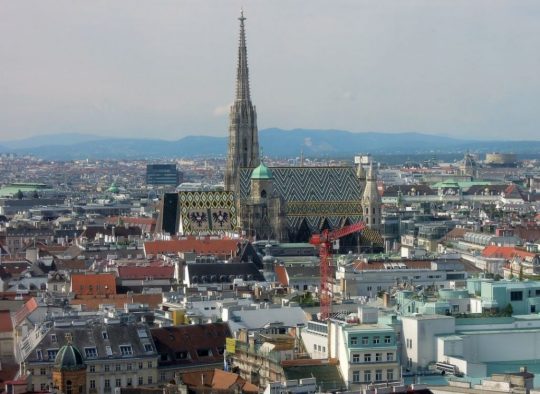
View of the church in Vienna / Pixabay
2. The Romanesque towers were completed in the mid-13th century
The original church on the site was built in the 12th century in the Romanesque architectural style. It was founded in the year 1137 and the initial construction phase was completed in 1147, which is the year the church was dedicated to Saint Stephen. This was an important event as it was the moment that Conrad III of Germany and his gang were getting ready to start their Second Crusade (1147-1150). The first church on the site was completed in the year 1160 and subsequently expanded between 1230 and 1245. This is when the 2 magnificent Romanesque towers we can still see today were completed. These towers stand 65 meters (213 feet) tall and are commonly referred to as the "Heidentürme," a reference to the fact that they were built on top of the Roman fortification. "Heiden" translates to "Pagans," so "Pagan Towers."
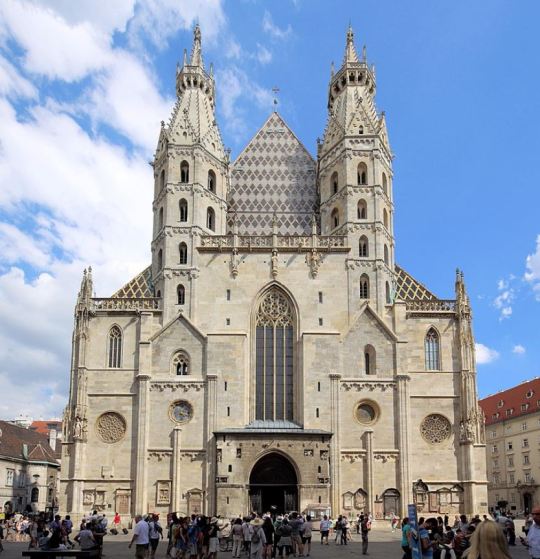
The Romanesque towers / Bwag / https://creativecommons.org/licenses/by-sa/4.0
3. The second church here dates back to the 13th century as well
Even though the two Romanesque towers were completed in 1245, the structure around them doesn't date back to this period. That's because a great fire destroyed much of the structure in 1258, except for these two towers. The towers were simply incorporated into an even bigger structure which was completed and dedicated shortly after on April 23, 1263. One of the most remarkable facts about St. Stephen's Cathedral is that this dedication in the 13th century is still commemorated every year. On this day, the big bells inside the tower ring for 3 minutes straight.

Detail of the old Romanesque part of the cathedral / Pixabay
4. The Gothic church we see today was finally completed in 1511
It didn't take long before another expansion phase was started, this time in the Gothic architectural style. In the early 14th century, King Albert I commissioned the Gothic choir which consists of 3 naves. This work was completed between 1304 and 1340 and dedicated by Albert's son, Albert II. This wasn't enough because Albert I's grandson, Rudolph IV or "Rudolph the Founder," started the construction of the westward Gothic extension of the church. The overall design of the church we see today with all its features was completed in 1511, the year that construction on the cathedral was halted altogether.
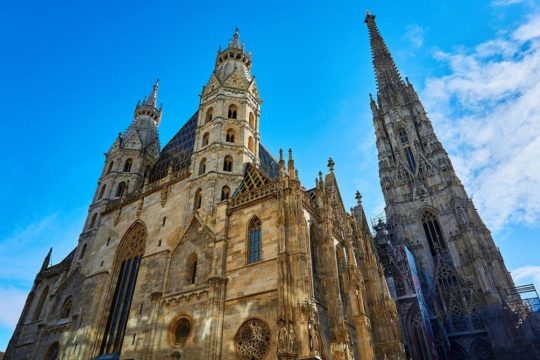
View of the Gothic additions to the cathedral / Pixabay
5. The main spire reaches the height of a modern-day skyscraper
During the final expansion phase, the church was seriously enlarged. It has a total length of 107 meters (351 feet) and a width of 70 meters (230 feet). The most prominent feature of this fascinating cathedral is the southern tower of which the spire reaches a height of 136.7 meters (448 feet). This tower was completed in 1433 and its height is the equivalent of an amazing skyscraper which turns it into the most dominant building in the area.

Drawing of the cathedral in 1847 / Wiki Commons
6. The north tower was intended to resemble its taller brother
The church could have been even more imposing if the original plan was completed. This would have turned the north tower into the twin brother of the south tower, but this plan was eventually abandoned when work seized in 1511. The construction of this tower was started in 1450 and it eventually reached a height of 68.3 meters (224 feet). Because the original plans were abandoned, this tower was topped with a Renaissance roof in the year1568, a common feature during the 16th century.

The north and south tower of the cathedral / Bwag / https://creativecommons.org/licenses/by-sa/4.0
7. The main door is probably named after a prehistoric animal
The main entrance of the church has its own name as it's referred to as the "Riesentor," or the "Giant's Door." There are a couple of theories as to why it's referred to as such, but it's assumed that it refers to the thighbone of a mammoth, a giant prehistoric animal. This thighbone was excavated during the construction in 1443 and dangled above this door for multiple decades. To both sides of this door we can find the old Romanesque towers from the 13th century.

Detail of the Riesentor / Uoaei1 / https://creativecommons.org/licenses/by-sa/3.0/deed.en
8. The most amazing feature of the church is its tiled roof
One of the most amazing facts about St. Stephen's Cathedral is that it features a magnificent roof that is covered with a grand total of 230,000 glazed tiles. This roof has a length of 111 meters (364 feet) and the south side depicts the symbol of the Austrian Empire under Habsburg rule, the double-headed eagle. The north side of the north depicts the coat of arms of both the City of Vienna and of the Republic of Austria, a remarkable sight to behold!

Detail of the tiled roof / Bwag / https://creativecommons.org/licenses/by-sa/4.0
9. It's home to the third-largest swinging bell in Europe
The cathedral's towers are home to a total of 23 ringing bells. The largest of them all is called the "Pummerin," or "Boomer," and is located inside the north tower. The original Pummerin was cast from 208 cannons captured from Muslim invaders during the Second Turkish Siege of Vienna in 1683. This enormous bell weighed 18,161 kilos (40,038 lbs) and it took over 15 minutes of 16 men pulling on a rope for the bell to ring. Unfortunately, this old bell was destroyed in the aftermath of World War II and replaced with the "New Pummerin" in 1951. The new bell weighs even more at 20,130 kilos (44,380 lbs), a weight that makes it the third-heaviest swinging bell in Europe. Only the Petersglocke in Cologne Cathedral (23,500 kg / 51,810 lbs) and the Maria Dolens (22,700 kilos / 50,044 lbs) in Rovereto, Italy, are heavier.

The famous Pummerin / Gryffindor / https://creativecommons.org/licenses/by-sa/3.0
10. A presumed miracle brought a Hungarian icon to the church
The interior of the cathedral is equally impressive as the exterior and multiple famous works of art can be found here. One of these is the "Pötscher Madonna," a Byzantine-style icon of St. Mary with baby Jesus that It was created in 1676 and brought to the church in the late 17th century from the church of Pócs in Hungary for a particular reason. After Holy Roman Emperor Leopold I received the word of the icon shedding tears on two different occasions, he ordered to be brought to Austria. It arrived in Vienna after a 5-month journey in 1697 but hasn't been seen shedding tears since. It can now be found in the southwest corner of the nave of the cathedral.
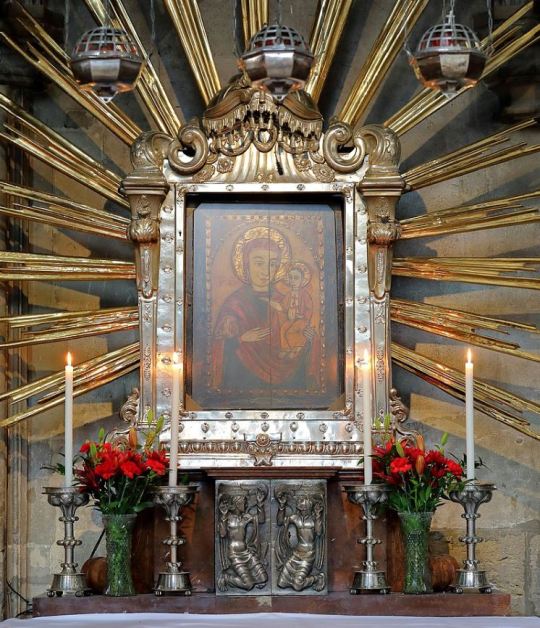
Pötscher Madonna / Bwag / https://creativecommons.org/licenses/by-sa/4.0
11. The 15th-century Altar underwent a costly 20-year restoration
The High Altar is the first one a visitor notices when entering the church. This Baroque altar was completed between 1641 and 1647 and represents the stoning of Saint Stephen, the martyr to whom the church was dedicated. The other famous altar in the church is the so-called Wiener Neustädter Altar, an altar that was commissioned by Emperor Frederick III in the year 1447. This altar wasn't moved to the cathedral until 1885 as it originally decorated the Cistercian Viktring Abbey near Klagenfurt (until 1776) and the Cistercian monastery of St. Bernard of Clairvaux in Wiener Neustadt. On its 100th anniversary in the church in 1985, a restoration program was started which would take 20 years to complete at a cost of 1.3 million Euro. It's only opened during weekends and opened up it depicts events in the life of the Virgin Mary. If closed, it depicts a painting involving 72 saints.
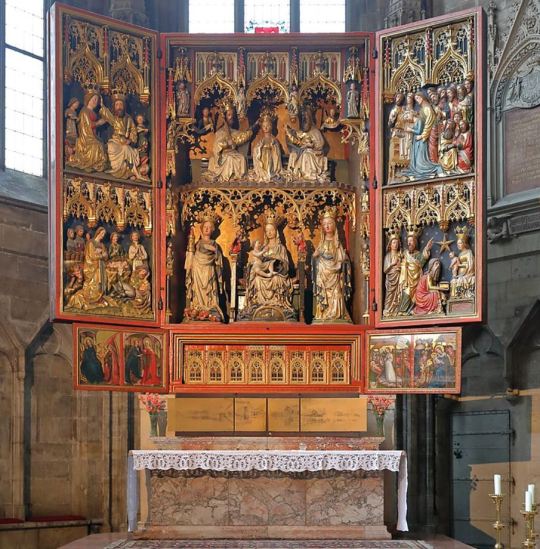
Wiener Neustädter Altar / Bwag / https://creativecommons.org/licenses/by-sa/4.0
12. A sculptor probably eternalized himself below the pulpit's chair
One of the most remarkable works of art is the stone-cut pulpit which is situated against one of the pillars of the nave of the cathedral. The sculptor is believed to be Dutch-born Nikolaus Gerhaert (1420-1473), but he didn't manage to steal the show so-to-speak. Below the pulpit, we can see the image of a man peaking through a window. This is believed to be a self-portrait of an unidentified sculptor who is referred to as the "Fenstergucker," or "Window Peaker."
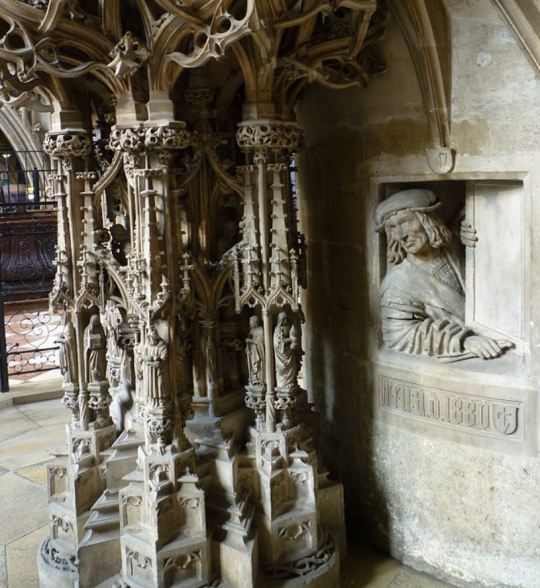
Fenstergucker in St. Stephen's Cathedral / Uoaei1 / https://creativecommons.org/licenses/by-sa/3.0/deed.en
13. Some very famous people are buried inside the church
The Dutch sculptor who created the magnificent pulpit is also responsible for the creation of the tomb of Emperor Frederick III (1415-1493). This work started 25 years before his death and would take 45 years to complete. He's far from the only person who ended up being buried in the church as it's also the final resting place of Prince Eugene of Savoy (1663-1736) and 72 other members of the Habsburg Dynasty of the Austrian Empire whose remains are in the crypt.

Tomb of Emperor Frederick III / Bwag / https://creativecommons.org/licenses/by-sa/4.0
14. The south tower was completely restored in the 2000s
During the 2000s, the exterior of the church has been restored as the accumulated dirt turned most parts of the stones completely black. The most prominent feature of the church, the south tower, was restored as well. This restoration project, which mostly involved cleaning the limestone) was finally completed in the year 2008 and the south tower pretty much looks brand new again!
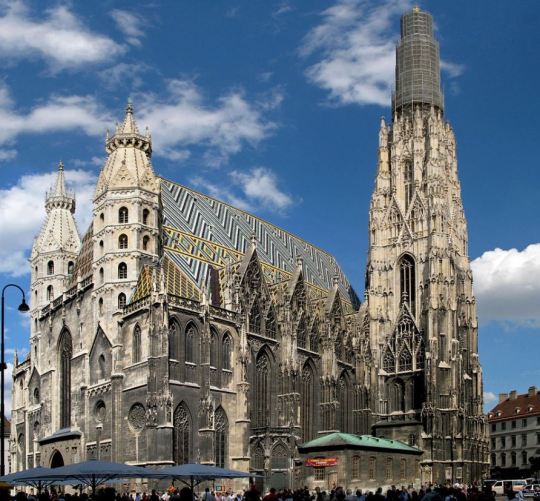
The south tower during restoration / Andrew Bossi / https://creativecommons.org/licenses/by-sa/2.5
15. The interior looks amazing after a renovation as well
One of the most fascinating facts about St. Stephen's Cathedral is that the interior looks amazing as well, especially following a similar renovation project. The cathedral features several chapels which are adorned with statues and amazing works of art. This means that entering the church is a must-do item on your Vienna bucket list!
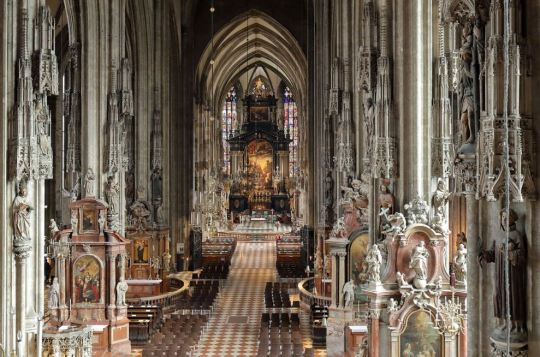
The amazing interior of the Vienna Cathedral / Bwag / https://creativecommons.org/licenses/by-sa/4.0 Read the full article
#Architecture#Churches#famouschurches#famouschurchesintheworld#FamousGothicCathedrals#LandmarksinVienna#MostfamousGothicCathedrals#StStephensCathedral#StStephensCathedralfacts#Vienna
1 note
·
View note
Text
BASTIAN Gallery, Berlin Dahlem
BASTIAN Gallery, Berlin Dahlem Building Project, German Architecture News, Images
BASTIAN Gallery, Berlin Dahlem
16 Oct 2020
BASTIAN Gallery
Architect: John Pawson
Location: Berlin, Germany
The Bastian family will establish a new gallery space in Berlin Dahlem, Taylorstraße. With construction already underway, the opening of the gallery space is scheduled for Autumn 2021.
The BASTIAN Gallery building will be located on the periphery of a park not far from Grunewald and, designed by renowned architect John Pawson, it will respect the proximity and context of the nature park by opting for the typology of a pavilion-like form.
John Pawson is considered one of the most important architects of our time. The international prestige of the British architect is built upon his uncompromising dedication to the principle of clarity. In the reduction of his designs, he strives for simplicity as perfection.
In 2019 Céline, Heiner and Aeneas Bastian donated their gallery building Am Kupfer-graben in Berlin Mitte to the Prussian Cultural Heritage Foundation to help establish a centre for cultural education next to Museum Island. An exhibition space was also opened in the heart of Mayfair in London in 2019; the gallery continues to expand and fortify its international presence.
The new Berlin gallery will continue its exhibition programme of German and American post-war modernism from next autumn. The exhibitions will be accompanied by public lectures, readings, and concerts. The events will be open to the public and free of charge.
Aeneas Bastian comments, The decision to open a new location in Berlin is a sign of confidence in a difficult time due to the consequences of the pandemic and a firm commitment to Berlin as an important place for art.
Established by Céline and Heiner Bastian in 1989, the gallery is directed by Aeneas Bastian since 2016. 20th Century artists, such as Pablo Picasso, Jean Dubuffet, as well as German and American post-war artists including Joseph Beuys, Anselm Kiefer, Cy Twombly, Robert Rauschenberg and Andy Warhol, form the core of the exhibition program.
The gallery publishes numerous exhibition catalogues, artist monographs and catalogues raisonnés. BASTIAN participates at international art fairs, such as MASTERPIECE London, Taipei Dangdai, Art Cologne and Art Düsseldorf.
From 2007 until 2019 BASTIAN Berlin has shown exhibitions dedicated to modern and contemporary art. At the beginning of 2019, the Bastian family donated their building Am Kupfergraben to the State Museums of Berlin, who have established an art education center there, which was inaugurated on 1 September 2019.
Located in Mayfair, the London gallery opened on 1 February 2019. Since its opening the gallery has presented solo exhibitions of Andy Warhol, Cy Twombly, Joseph Beuys, Dan Flavin and Hans Hofmann.
Architects: John Pawson
Image ® John Pawson Ltd, Courtesy BASTIAN.
BASTIAN Gallery, Berlin Dahlem images / information received 161020
OMA, architects
Location: Axel-Springer-Straße 65, 10888 Berlin, Germany
Architecture in Berlin
Berlin Architecture Designs – chronological list
New Media Campus for Axel Springer in Berlin Design: BIG + Bollinger+Grohmann + Man Made Land +Topotek 1 + Kardoff Ingenieure + Wenzel+Wenzel image by architects Media Campus Axel Springer Another of the three shortlisted entries for the new Media Campus for AXEL SPRINGER in Berlin, Germany.
Berlin Buildings
Berlin Architects
Berlin Architecture Walking Tours
Dutch Embassy Berlin
Jewish Museum Berlin
German Architecture
German Architects
Berlin Architecture
Comments / photos for the BASTIAN Gallery, Berlin Dahlem Architecture page welcome
Berlin
The post BASTIAN Gallery, Berlin Dahlem appeared first on e-architect.
0 notes
Text
Fwd: Postdoc: UCologne_Germany.PlantEvolutionarySystemsBiology
Begin forwarded message: > From: [email protected] > Subject: Postdoc: UCologne_Germany.PlantEvolutionarySystemsBiology > Date: 15 January 2022 at 07:41:49 GMT > To: [email protected] > > > 1 Postdoc position - 36 Months > Evolutionary Systems Biology in Arabidopsis lyrata > Lab. J. de Meaux - Cologne > > Recently, our lab started to explore the genomic and evolutionary > features that associate with the mode of gene expression inheritance. By > bridging approaches in population genetics and transcriptomics with the > traditions of quantitative genetics, we systematically dissect the > component of genetic variation that can directly sustain a response to > selection and try to understand the factors that influence the adaptive > relevance of specific molecular plant traits. The postdoctoral research > associate will expand this line of work and integrate epigenetic, > transcriptomic and phenotypic analyses of variation in the obligate > outcrossing species A. lyrata. In close collaboration with our > international team, the postdoc will also mentor students and actively > participate to the lively scientific culture of our lab. > > This project is funded by the German Ministry of Research and Education > (BMBF) for 36 months. The applicant must hold a PhD in Evolutionary > Biology or Quantitative Genetics (Comparative Genomics, Evolutionary > Genetics, Plant Breeding or Population genetics) and hold advanced > skills in bioinformatic analysis of omics data. Language in the lab is > English. Applications or questions regarding the position should be sent > by mail to [email protected], with the following subject line – > Postdoc application Evol Sys Arabidopsis – de Meaux lab. A letter of > motivation, a CV and the contact of 3 referees should be provided, all > in a single pdf file. Revision of applications will begin in February > 15th 2022 and continue until the position is filled. Funding is for up > to 3 years starting on April 1st 2022 (flexible starting date). For more > information on our lab and research, visit our website > https://ift.tt/2OqstBD. Applicants still in the > process of completing their PhD are encouraged to informally contact the > PI if they have questions concerning the position. The University of > Cologne is an equal opportunity employer in compliance with German laws. > People with disabilities are strongly encouraged to apply. Women are > also strongly encouraged to apply. > Cologne is Germany’s vibrant Metropolis on the Rhine. The city is well > known for its wild carnival, its famous Kölsch beer, its Cathedral and > its vivid contemporary art and musical scene. Cologne is the fourth > biggest city in Germany with over a million inhabitants from all over > the world and an interesting mix of restored historic buildings and > modern post-war architecture. Most importantly, Cologne University is > one of the oldest and largest Universities in the Country. Our research > group is hosted at the Biological Center of the University of Cologne > and associated to the Collaborative Research network SFB680 > (https://ift.tt/3tpc80W) and to the Excellence Research Cluster > CEPLAS (http://ceplas.eu/de/), which fosters active interactions between > plant scientists of the Universities of Cologne, Düsseldorf and the Max > Planck Institute of Plant Breeding Research. In this context, our lab > members are assured to start their scientific career in a world-class > scientific environment. > > > > > Prof. Dr. Juliette de Meaux > University of Cologne > Plant Molecular Ecology > Institute of Botany > Biozentrum > Zülpicher str. 47b > D-50674 Cologne > Germany > > Tel: +49 221 470 8213 > [email protected] > > https://ift.tt/2OqstBD > > > Juliette de Meaux > via IFTTT
0 notes